This is the ULTIMATE GUIDE to building your Fuji X-mount lens line-up!
In this part, we’ve got a complete list of all official Fuji X-mount prime lenses, to help you select the best Fuji prime lenses for your kit.
We’ll be adding third-party X-mount prime lenses soon, followed by a complete list of Fuji zoom lenses.
Fujifilm has a great reputation for producing high quality optics in their entire line of lenses, from the high-end pro lenses all the way down to the unique variable aperture kit zoom lenses like the Fujinon 18-55mm f/2.8-f/4.
But for those of us who love small mirrorless systems, where Fuji really shines in the primes department. Not only do they offer some of the best bang-for-the-buck primes in any system right now, they arguably have some of the best price-to-quality offerings in prime lenses.
The Fuji prime lens strategy is unlike that of other manufacturers. I’d even go as far to say that Fuji offers one of the best prime lineup, pound-for-pound, in any system right now. And I mean any system – full frame, micro four thirds, APS-C. They’ve really come a long way from the initial launch of the X-system in 2012.
While they make some interesting zooms (like the 18-55mm f/2.8-f/4 zoom) I’ve come to have a great appreciation for their primes. As someone who prefers shooting with lightweight and small lenses, what initially drew me to the Fuji prime lenses are their smaller size compared to full frame or even other APS-C lenses. But like many Fuji shooters, I found myself impressed with the quality, contrast and color rendition of these Fujinon lenses.
RELATED: The best retro style digital cameras, featuring lots of Fuji cameras!
Complete list of Fuji prime lenses – quick specifications:
| Lens | Weight: | Filter size: | Features: |
|---|---|---|---|
| Wide angle lenses: | |||
| Fuji 14mm f/2.8 | 235g | 58mm | Push pull focus ring with distance scale |
| Fuji 16mm f/1.4 | 375g | 67mm | Push-pull focus ring with distance scale |
| Fuji 16mm f/2.8 | 155g | 49mm | Weather resistant |
| Fuji 18mm f/2 | 116g | 52mm | |
| Fuji 23mm f/1.4 | 300g | 62mm | Push-pull focus ring with distance scale |
| Fuji 23mm f/2 | 180g | 43mm | Weather resistant |
| Fuji 24mm f/8 | 32g | N/A | Fixed focus, aperture fixed at f/8 |
| Standard primes: | |||
| Fuji 27mm f/2.8 | 78g | 39mm | Pancake lens with no aperture ring |
| Fuji 35mm f/1.4 | 187g | 52mm | |
| Fuji 35mm f/2 | 180g | 43mm | Weather resistant |
| Telephoto primes: | |||
| Fuji 50mm f/2 | 200g | 46mm | Weather resistant |
| Fuji 56mm f/1.2 | 405g | 62mm | |
| Fuji 56mm f/1.2 APD | 405g | 62mm | Comes with a 3-stop ND filter, included in the box |
| Fuji 60mm f/2.4 | 215g | 39mm | Capable of 1:2 macro |
| Fuji 80mm f/2.8 | 750g | 62mm | Capable of 1:1 macro; compatible with 1.4X and 2X teleconverters; weather resistant |
| Fuji 90mm f/2 | 540g | 62mm | |
| Fuji 200mm f/2 | 2265g | 105mm | Weather resistant; 1.4x teleconverter included in box |
Wide Angle Prime Lenses:
Fuji 14mm f/2.8
Currently the widest Fujinon X-mount prime available, this all-metal barreled ultra-wide lens (21mm-equivalent) has very little to no distortion, which is remarkable for a lens this wide and of this size. It is sharp from corner-to-corner, especially when stopped down just a bit to f/4.
When it first came out, many considered it a ‘large’ lens, but that was only when comparing it to the Fujinon lenses available at that time. This remains one of the most compact 21mm-equivalent lenses for APS-C (or larger sensors) – in any system. It actually balances well on smaller Fuji bodies like the X-T30 or X-E3.
The biggest negative to this lens is the lack of weather sealing (for that, you’d have to look at the 16mm f/1.4 or 16mm f./2.8, see below). There is also some vignetting when wide-open, which doesn’t completely go away even at f/8. But this isn’t a problem if you shoot JPEG’s because the camera autocorrects for that, and most RAW converters can correct for it with just a click. Nothing out of the ordinary for such a small, fast and wide lens.
There is some coma when wide-open, but only in the far corners. Though it isn’t something I regularly photograph, I personally would have no problems using this for astrophotography. If you’re willing to crop a bit, it can be an excellent lens for astro.
It is also one of only three Fuji lenses (at this time) that feature a push-pull focus ring. This nifty design reveals an engraved distance scale and depth of field scale – just pull on the focus ring towards you to set the lens to manual focus and reveal the engraved scales. This is very useful for street shooting, or for landscape work.
Despite this being one of Fuji’s older lenses, it was one of the first lenses that received an updated noiseless AF motor, so AF-wise, it’s an upgrade to the first three Fuji X lenses (18mm, 35mm f/1.4, 60mm) when the system first launched.
Overall, the 14mm f/2.8 is one of the more unique lenses for Fuji. It’s got a unique mix of attributes that you can’t easily get in other systems, APS-C or full frame: i.e. the combination of build-quality, mechanical quality (e.g. push-pull ring with distance and DOF scales), the relatively small size and relatively fast aperture is hard to beat.
It’s closest competitor is the newer Fuji 16mm f/2.8 (see below). That one is smaller and weather-sealed, but at a 24mm-equivalent, it just isn’t as wide. For some, that might not matter, but for others, it will lack the drama that a 21mm-equivalent can produce.
Depending on your use-case, the 16mm f/2.8 might be a better option, since it gains the latest AF motor and weather resistance. As always, the deciding factor is likely going to be what other lenses you have in your bag. e.g. If you’ve got a 23mm, you’re probably better of with the 14mm as it will gap better. But if you’ve got the 27mm or the 35mm, the 16mm options might be more appealing.
Looking at other systems, the only other lens that comes to mind is the Pentax DA 15mm f/4 Limited – but that’s an f/4 lens. On full frame, you’ve got the likes of the excellent Zeiss Loxia 21mm f/2.8 for Sony E-mount, but that’s a manual focus lens that weighs quite a bit more too. Another lens for Sony full frame is the Samyang 18mm f/2.8, a tiny and ultra light lens, but it is quite a bit wider, so it’s not really similar. It also isn’t as great as the Fuji when shot wide-open.
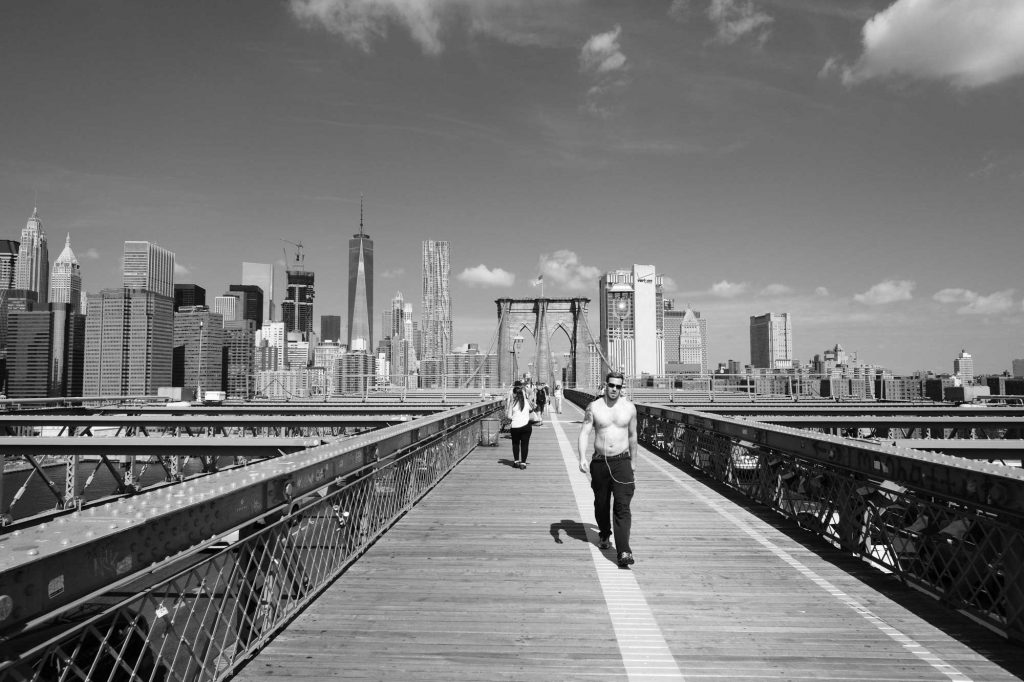
(c) Michael Behrens. Link. Creative Commons license.
Check the current price of the Fuji 14mm f/2.8 on Amazon.
Fujinon 14mm f/2.8 specs:
Filter size: 58mm | Weight: 235 grams | Size (LxW): 2.29″ x 2.55″ | Minimum Focus Distance: 7.08 inches | Hood included: Yes (it’s the same hood that comes with the Fuji 18-55mm kit zoom)
Fuji 16mm f/1.4 WR
Easily one of Fuji’s best lenses. And likely one of the best 24mm-equivalent primes ever made. This lens is weather sealed, is able to focus really close (and I mean really close), and is a fantastic low light lens – indoors, evening and night scenes, poorly lit events – you name it, this lens won’t break a sweat.
If this lens and the 14mm above are anything to go by, Fuji knows how to make wide-angle primes. There is very little distortion here and only some vignetting when shot wide-open. This is mostly all gone at f/2.8. It is sharp at the center at f/1.4 and is already very good edge-to-edge at just f/2.
Similar to the 14mm f/2.8 above, this lens also features a push-pull manual focus ring and engraved distance and depth of field scales. This is a really fantastic feature for anyone who shoots street photography using zone focusing or by pre-focusing.
It’s not everyone’s style, but personally, I find zone focusing to be faster than any AF system. And if you need AF, all you need is a quick push of the focus ring. Can’t get any easier than that. I don’t know why there aren’t more (wide) lenses designed with a push-pull ring like this.

The focal length, the push-pull manual focus ring and the fast aperture all combine to make this one of the most versatile lenses in Fuji’s lineup. Landscape, cityscape, nightscape, astrophotography, street photography, pseudo-macro, food photography, environmental portraits, low light – this lens can do it all. That it’s able to render great bokeh when shot wide open (for such a wide focal length) is just a bonus.
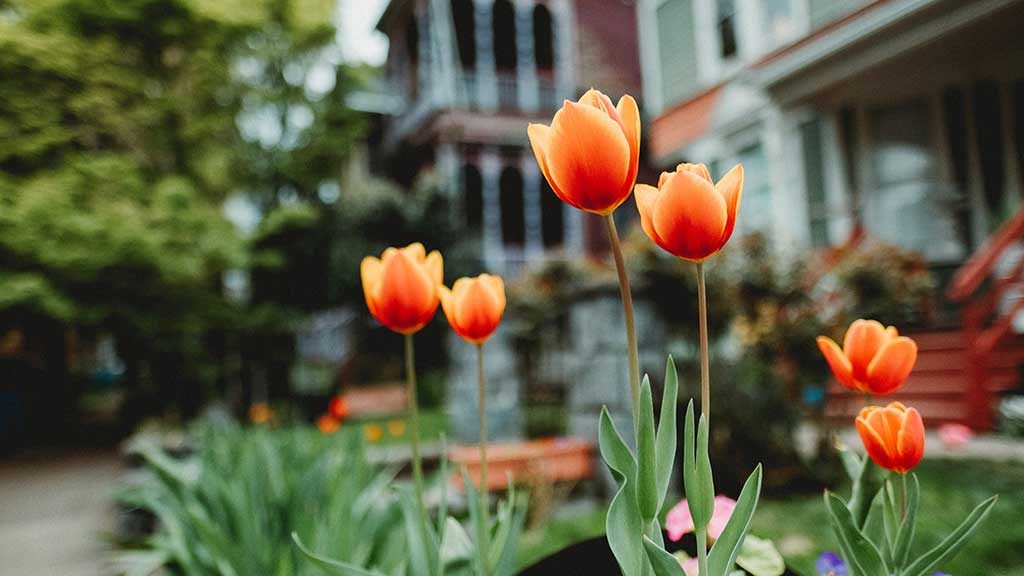
(c) malikali. Link. Creative Commons License.
Click here to check the current price of the Fuji 16mm f/1.4 on Amazon.
Fujinon 16mm f/1.4 specs:
Filter size: 67mm | Weight: 375 grams | Size (LxW): 2.87″ x 2.89″ | Minimum Focus Distance: 5.9 inches | Hood included: Yes (plastic hood) – but you can ‘upgrade’ to a metal hood (Fuji LH-XF16) if you wish.
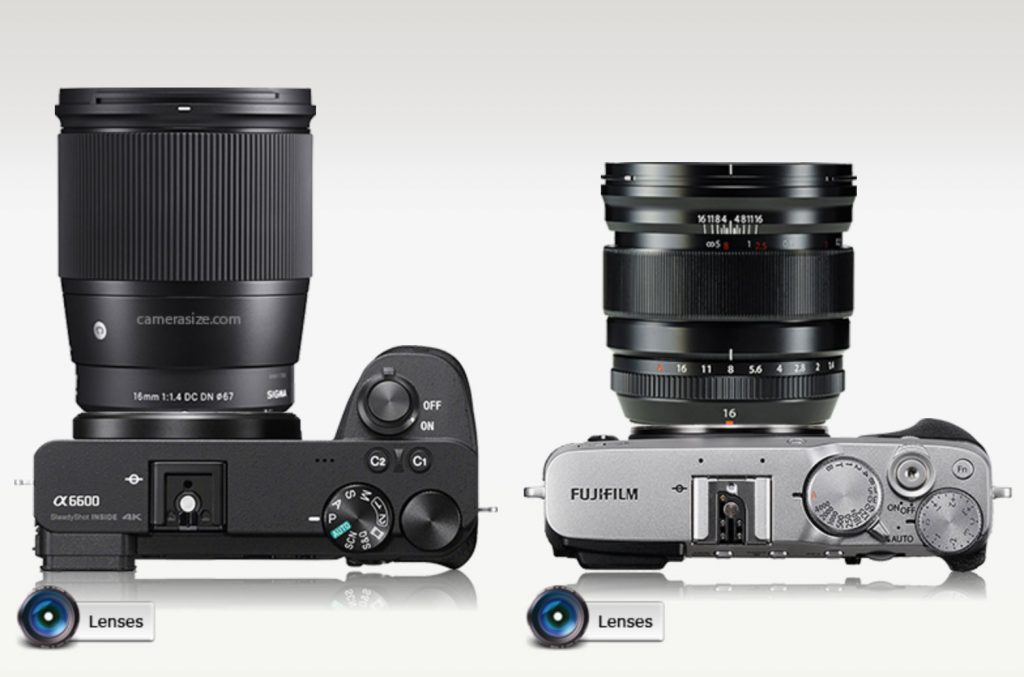
Fuji 16mm f/2.8 R WR
The newest addition to Fuji’s small, weather-sealed prime lens line-up. This lens first arrived in early 2019, and is meant to complement the “Fujicron” trio of compact Fuji f/2 weather sealed lenses – the 23mm f/2, 35mm f/2 and the 50mm f/2.
While it is a shame that the new 16mm isn’t also an f/2 lens, it’s the likely trade-off to get what is expected to be a very compact lens. And it’s a very compact lens indeed. It’s as small as the 35mm f/2, which is the smallest of the Fujicron lenses.
The “Fujicron” name is a play on Leica’s “Summicron” designation for its f/2 lenses. Leica calls their f/2.8 lenses “Elmarit”. So I guess this 16mm f/2.8 would technically be a ‘Fujimarit’?!?
With a 24mm-equivalent field of view, this new 16mm f/2.8 is also weather sealed, just like its f/2 siblings. Build quality is also similar, with a metal exterior and a fast and quiet focusing motor. It’s just as small as the 35mm f/2, having the same length, but the 16mm is slimmer than the 35mm f/2.
It’s a street shooters dream. Small, unassuming, fast. The only thing missing would be a distance scale. But that would likely mean a bigger and more expensive lens. It’s not a competitor the 16mm f/1.4 at all, since they’re built for different things.
It’s a full 2-stops slower than the 16mm f/1.4, but it also costs 3x less. Bottom line, if you want a compact street or travel wide-angle shooter, the 16mm f/2.8 is easy to recommend. But if you want a 24mm-equivalent do-it-all lens, you’re better off going with the 16mm f/1.4 Just be prepared to make space in your bag.
Click here to check the current price of the Fuji 16mm f/2.8 on Amazon.
Fujinon 16mm f/2.8 specs:
Filter size: 49 mm | Weight: 155 grams | Size (LxW): 1.78″ x 2.36″ | Minimum Focus Distance: 6.7 inches | Hood included: Yes
Fuji 18mm f/2
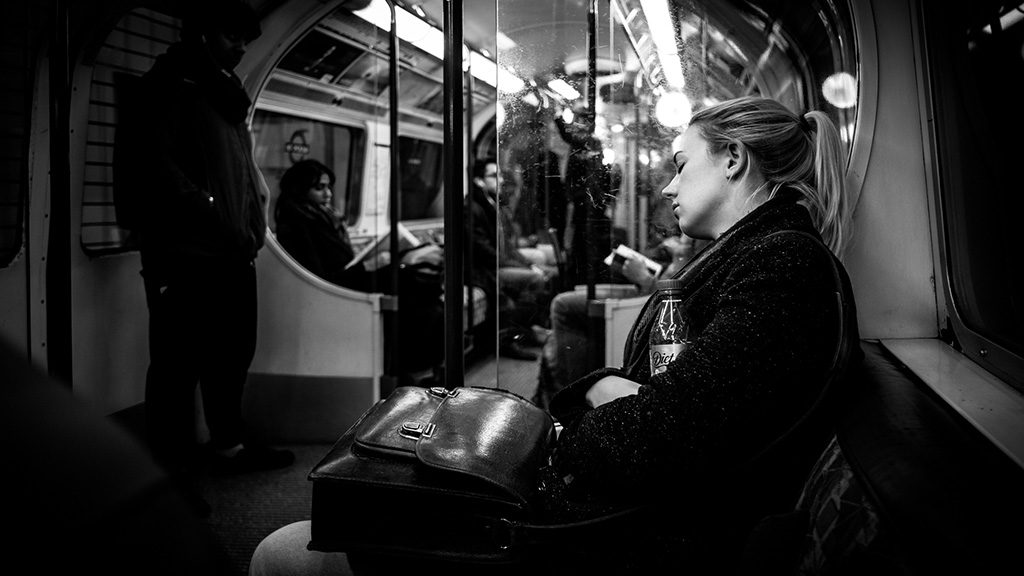
(c) Giuseppe Milo. Link. Creative Commons License.
This is one of Fuji’s most overlooked lenses, which is a bit unfortunate. The 18mm f/2.0 was one of Fuji’s original trio of X-mount lenses when the X-mount was first announced. Perhaps because it had the (mis)fortune of being released at the same time as the spectacular Fuji 35mm f/1.4, this 18mm pancake lens (27mm-equivalent) did not receive as much fanfare as its more celebrated sibling.
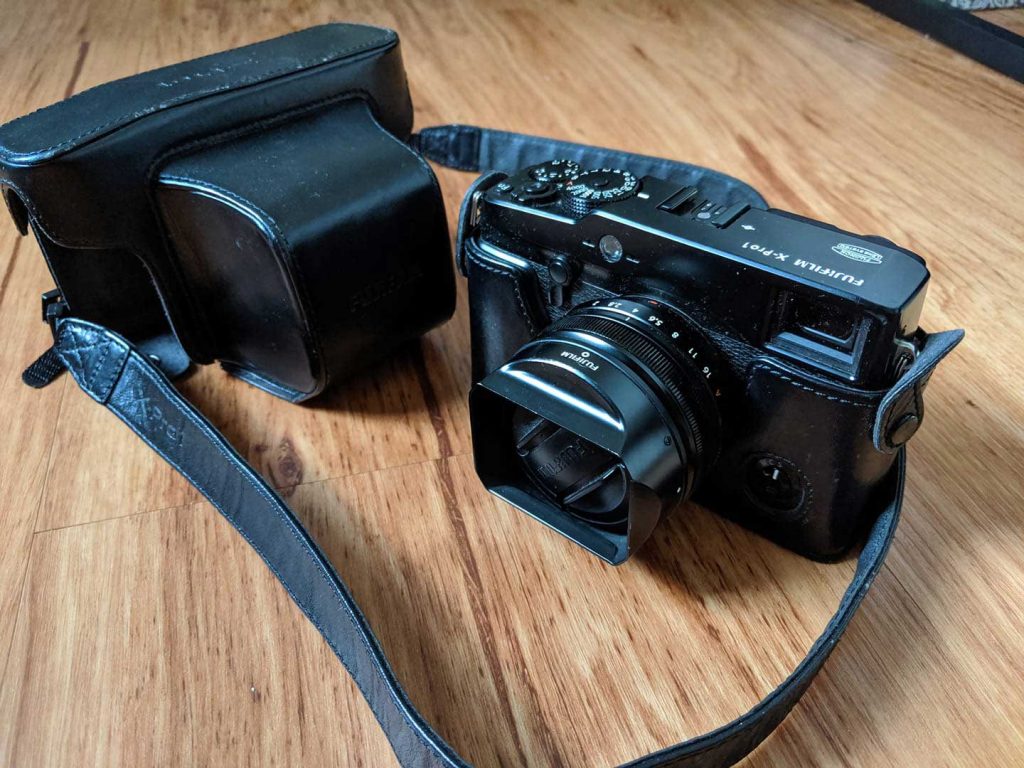
Much of the lukewarm reception for this lens comes from the fact that it’s not super sharp at the corners and has some vignetting wide-open, which doesn’t make it a great lens for ‘scapes.
Unfortunately, following initial reviews from “mainstream media” who shoot charts and brick walls, it just sort of got ignored. But it has slowly found fans: the few who were smart enough to look past the reviews and understand the lens for what it is.
At a 27mm equivalent field of view, it’s not a very sexy focal length. But then, if you consider that fact that the iPhone and most smart phones these days actually feature a similar field of view, you’ll realize that this is a focal length that’s suitable to a wide-range of subjects.
The most important thing to understand is that this is a bright wide-angle that weighs next to nothing. This is a lens that’s built for portability, without sacrificing low light performance.
It’s the perfect documentary lens. A story telling lens. The ideal street photography slash travel lens. It’s also the perfect ‘social’ lens. The tiny size means your subjects won’t feel intimidated and will feel more relaxed as you click away.
It’s the one lens you stick on a compact body like the Fuji X-E3, X-T30 or X-T20 and take for a night out. Or it’s the wide-angle companion that you stick in your pocket to pair with the Fuji 35mm (53mm equivalent-FOV) or 50mm (75mm equivalent-FOV).
Since it sticks out a mere 1.32 inches from the lens mount, it’s also the ideal lens to pair with bodies with optical viewfinders like the X-Pro2 since there is zero chance of blocking the optical viewfinder.
Sure, it’s not a lens for serious landscape or architecture shooters, but it’s more than good enough for the occasional landscape. Bottom line, if you value size and weight and still want that f/2 for low light shooting, this is the wide-angle to get.
Check the current price of the Fuji 18mm f/2 on Amazon.
Fujinon 18mm f/2 specs:
Filter size: 52mm | Weight: 116 grams | Size (LxW): 1.32″ x 2.53″ | Minimum Focus Distance: 7.1 inches | Hood included: Yes
Fuji 23mm f/1.4

(c) Tobias Zils. Link. Creative Commons License.
The classic moderate wide-angle focal length (35mm-equivalent FOV), this f/1.4 lens is fantastic for low-light situations and also provides some control of depth of field. If most Fuji shooters could only have one lens, I have a feeling many would gravitate towards this lens. For many, this could be a desert island lens.
Like the 14mm f/2.8 and 16mm f/1.4 (above) this lens also has a clutch focusing ring that allows for a push-pull action to move from manual focus to auto-focus. Pull the ring towards you to reveal an engraved distance scale and you’re in manual focus mode, push the ring away from you and you’re back in AF mode.
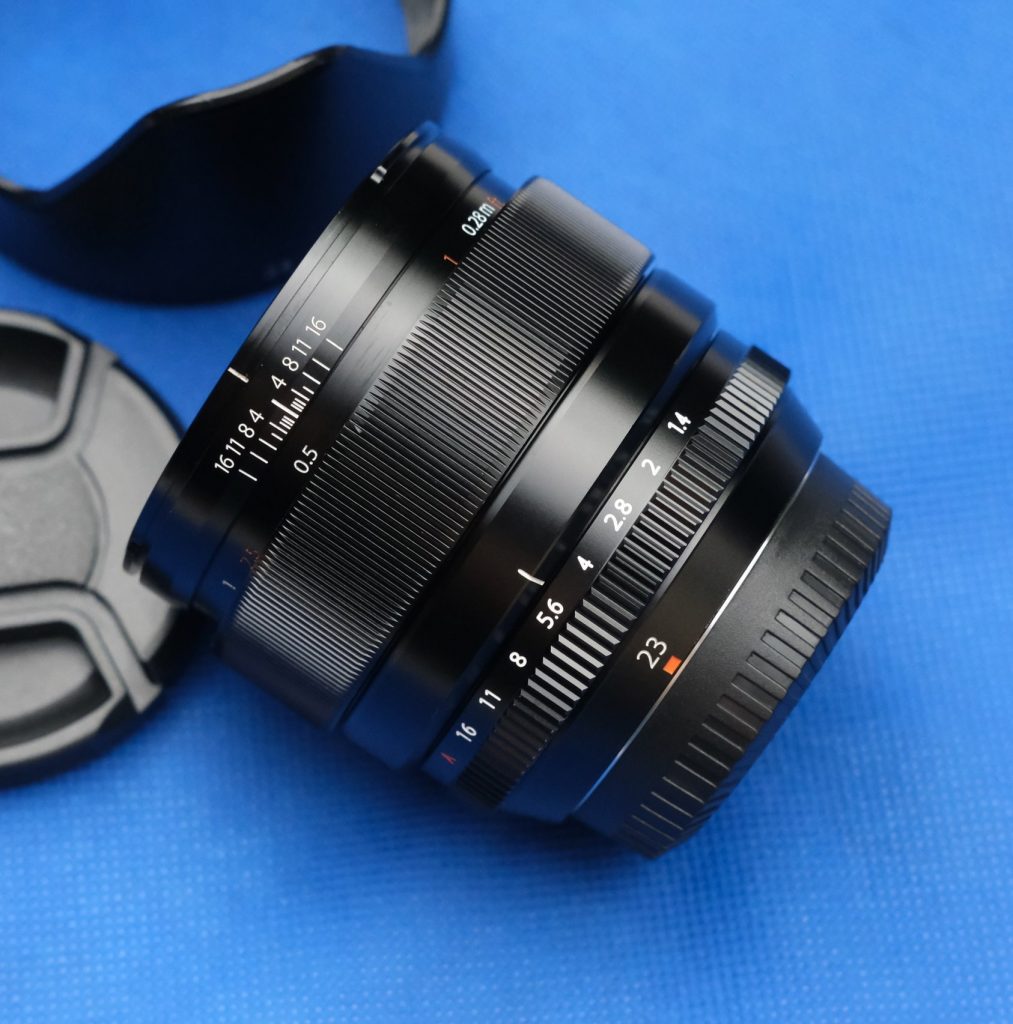
The focal length and fast aperture makes the 23mm f/1.4 a great everyday lens. But, it’s not the only fast 35mm-equivalent lens in Fuji’s lineup. Fuji have also released the 23mm f/2 WR lens which is smaller, lighter, and equipped with a newer auto focus motor and is fully weather-sealed too! (See below for more on the newer lens)
The Fuji 23mm f/1.4 is not a speed demon. Being one of the older lenses in the system, it doesn’t benefit from Fuji’s latest AF technology. It’s great for most everyday things, but not if AF speed is a priority. Auto-focus generates a bit of noise too, making it not so great for video, unless you’re using an off-camera microphone.
But what it does have over its newer counterpart is that ever useful extra stop at f/1.4 and the ability to quickly switch to manual focus with a simple push-pull of the focus ring. The engraved distance scale is also a must-have for those street photographers who love to zone focus. (Most Fuji cameras have an on-screen distance scale on the LCD if you set the camera to manual focus mode, but the on-lens solution on the 23mm f/1.4 is significantly faster in real world use, not to mention, it is much more pleasurable to use)
If you wanted a lens that could shoot street photography in the morning, a family BBQ in the afternoon, then shoot a band in a dimly lit pub in the evening, this is it.

(c) Willy Verhulst. Link. Creative Commons License.
The 35mm-equivalent field of view is a very natural field of view and is useful in a variety of situations. It’s perfect for capturing everyday life. Wide enough to add some drama, especially if you shoot close to your subject, but not too wide that you worry about distortion all the time. The bright f/1.4 aperture will keep you shooting even in low light, add that to the 7 rounded aperture blades and this lens is more than capable of blurring backgrounds for environmental portraits.
Check the current price of the Fuji 23mm f/1.4 on Amazon.
Fujinon 23mm f/1.4 specs:
Filter size: 62mm | Weight: 300 grams | Size (LxW): 2.48″ x 2.83″ | Minimum Focus Distance: 11 inches | Hood included: Yes – the hood that comes with the lens is the ridiculously large petal hood made of plastic; you can get a third party hood like the JJC LH-XF23 hood, an aluminum hood that is much smaller than the stock hood.
Fuji 23mm f/2 WR
Announced three years after its f/1.4 sibling (see above), this 23mm f/2 lens is the second 23mm lens in the Fuji lens lineup. It’s smaller, lighter, faster AND quieter to focus than its older brother. And, it’s cheaper than the 23mm f/1.4. Oh, and it’s weather sealed too.
At f/2, it’s 1 stop slower than the f/1.4, so it’s slightly less useful in low light and won’t be able to blur backgrounds as much. Street shooters will miss the built-in distance scale (Fuji bodies do show a digital distance scale on the LCD when in manual focus mode).
But you do gain weather sealing, which is not something you usually expect in this price range.
Not only is this lens smaller and lighter than its f/1.4 counterpart (180 grams vs 300 grams), the lens barrel also features a tapered design, which makes it ideal for Fuji bodies with an optical finder, like the Fuji X-Pro2 or X-Pro1.
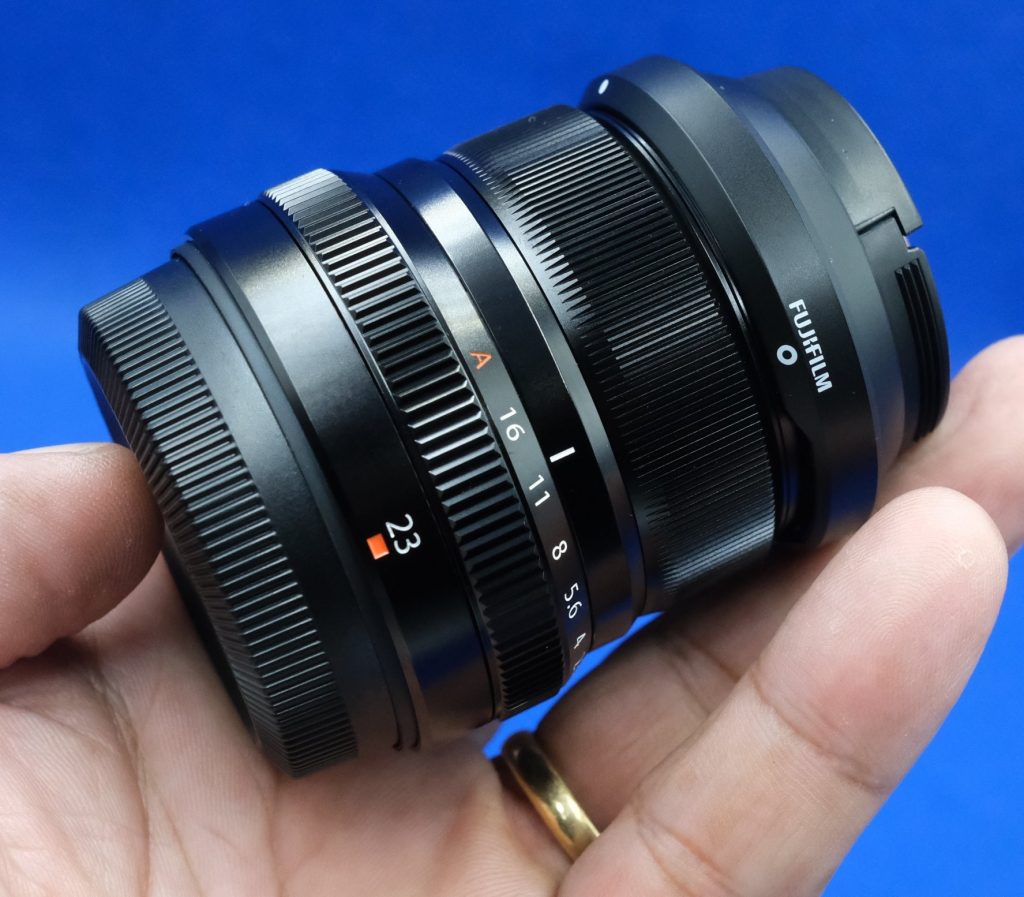
This tapered barrel design (i.e. the lens is fatter on the lens mount end and thinner towards the front) means you’ll be able to see the entire frame on the cut-out viewfinder of cameras like the X-Pro series (the 23mm f/1.4 and other larger lenses will block some or most of the optical viewfinder, forcing you to use the EVF or the back LCD if you want to see the entire frame).
While the lens no longer features a push-pull focus ring, it is still built extremely well. If you expected lower build quality because of the cheaper price, you’d be mistaken. If anything, I’d say this lens actually feels better built than the 23mm f/1.4.
It’s still got a metal body, and in everyday use you can tell that it is built with great tolerances. I find the focus ring and the aperture ring to actually be better on the 23mm f/2 than on the f/1.4. The rings are smooth, but have a nicer resistance that doesn’t lend itself to being easily nudged by mistake.
Optically, this lens is very good. The f/1.4 lens (above) is slightly sharper, especially at f/4 and wider, but you’ll really only see it if pixel peeping. Optically, the biggest difference is in performance at closer focusing distances. The f/1.4 lens performs noticeably better (i.e. is sharper) at closer focusing distances. But on the flip side, the f/2 lens is able to focus much closer.
Some reviews like to make a big deal out of the ‘softness’ at close focusing distances, but it’s really not that big a deal. It’s sharp enough, and you really only notice it when testing directly against another lens. I have a feeling most people would happily trade some sharpness for all the other benefits that this lens offers – significantly faster AND quieter auto-focus, weather sealing, smaller size and less weight and a happier wallet.
To me, close focus performance isn’t the deciding factor. Size and speed is.
It’s a tough decision, whether to get the 23mm f/1.4 vs the 23mm f/2. The way I see it is this: If you could have only one lens, get the 23mm f/1.4. If size is a priority, get the 23mm f/2. If you’re looking to build a kit based on size and weight, get the 23mm f/2, as it will pair nicely with the other f/2 Fujicrons like the 35mm f/2 and the 50mm f/2.
If you want something for video, definitely get the 23mm f/2. If you want something that AF’s quietly, get the 23mm f/2.
If you shoot a lot in low light, the 23mm f/1.4 is obviously the way to go. Pair it with the 56mm f/1.2, and you’ve got a killer two lens combo perfect for documentary, weddings and almost everything in between.
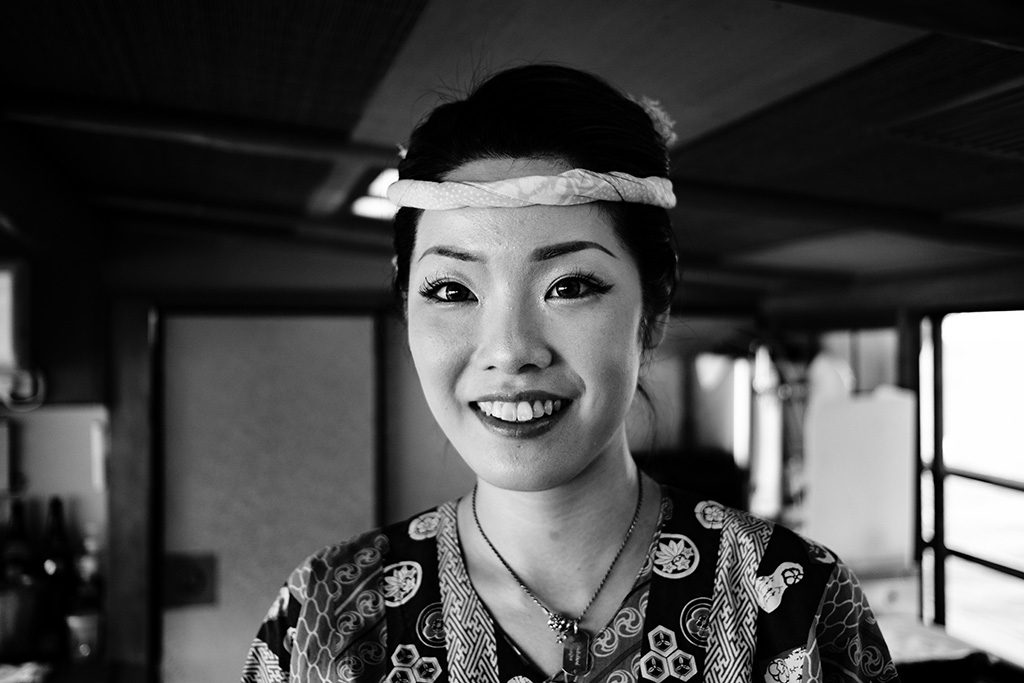
(c) Andrea Belvedere. Link. Creative Commons License.
Check the current price of the Fuji 23mm f/2 WR on Amazon.
Fujinon 23mm f/2 specs:
Filter size: 43mm | Weight: 180 grams | Size (LxW): 2.04″ x 2.36″ | Minimum Focus Distance: 8.66 inches | Hood included: Yes, it comes with a small low-profile hood. If you want something that looks better, you can get a third-party square hood, like this one. Alternatively, the ‘newer’ version of the Fuji LH-XF35-2 (a vented hood that is much nicer looking) will also fit the 23mm f/2. The ‘older’ version of this hood will still fit the 23mm f/2, but it isn’t a perfect fit. I put ‘newer’ and ‘older’ in quotes, since officially there aren’t two versions of the hood, but Fuji quietly upgraded the LH-XF35-2 so that it would fit the 23mm f/2 better.
Fuji 24mm XM-FL Bodycap lens
This is probably one that most Fuji shooters don’t have in their bag. The XM-FL is a ‘toy lens’ that is currently only officially available in Japan.
It’s an all-manual 24mm f/8 pancake lens (37mm-equivalent) with built-in filters that can be rotated via a dial on the side of the lens. It’s all manual – meaning, focus is fixed, and aperture is also fixed to f/8. There is also no electronic communication with the camera, so there is no EXIF date recorded.
The lens is all plastic, and is all fun. You use a rotary dial to select what ‘filter’ to use. There are notches on the dial to determine what filter is currently in use. One notch on the dial means you use the lens normally. 2 notches means a star filter, 3 notches is for soft focus and zero notches means you’re using it as a body cap.
If you really want one, you’ll have to resort to eBay or ordering directly from Japan as it is currently not available for retail in the US or anywhere outside of Japan.
Macfilos has a great write up of the Fuji XM-FL here.
Fuji 24mm f/8 bodycap lens specs:
Filter size: None | Weight: 32 grams | Size (LxW): 0.8″ x 2.28 | Minimum Focus Distance: 39.3 inches | Hood included: No. The only thing that comes with it is the rear cap.
Standard Prime Lenses:
Fuji 27mm f/2.8 Pancake Lens
Currently the most compact lens in the entire Fuji lens lineup, the 27mm f/2.8 (41mm-equivalent) is a tiny (!) pancake lens that is less than an inch thick and will pair nicely with Fuji’s smallest cameras like the X-E3, X-T20, X-T100, X-A5. At a mere 78 grams it is also the lightest Fujinon lens in the line-up.

But in order to keep the size really small, the lens does not come with an aperture ring like all other Fujinon lenses. For some, this isn’t going to be a problem, but for others, it could be a deal breaker because it will mean you need to shoot differently (against muscle memory) since you’ll need to use your camera body to set your aperture.
You’ll have to decide if you want the tiny size, and are willing to give up an aperture ring for that. And I do mean this thing is tiny. It’s about the size of some body caps or lens caps. But despite the small size, this performs better than many other pancake lenses I’ve tried (with the possible exception of the excellent Pentax 43mm f/1.9). The main thing it shares with other pancakes is a not-so-great minimum focusing distance (just over 13 inches).
It’s also the only 40mm-ish equivalent prime lens in the entire Fujifilm lineup. A lot of photographers love this focal length because it strikes a nice balance between the common 50mm-equivalent and the wider 35mm-equivalent or 28mm-equivalent focal lengths. So if you want a 40mm-equivalent, and wanted autofocus, this is currently the only game in town.
Optically, the 27mm f/2.8 is a very good lens. It’s already great wide-open, that you won’t feel the need to stop it down just to get some extra sharpness. With an f/2.8 maximum aperture, it’s not going to give you bokehlicious images, but that’s not really what this lens is for. Pair this with a small Fuji body, like the Fuji X-E2, X-T20, X-T30, X-T100, and you’ve got a really compact set-up that’s as small as the Fuji X100T, X100F etc.. Plus, you get all the benefits of an interchangeable lens system.
Overall, this is a bit of a niche lens. On paper, it’s just not very sexy, which limits its appeal. With an aperture of “just” f/2.8, it’s not going to satisfy bokeh lovers. The lack of an aperture ring will also frustrate some users. But if you love the 40mm-equivalent field of view, and are looking to keep the size and weight down, the 27mm f/2.8 is a fantastic option. Stick it in your pocket and pair it with a wide lens like the 14mm f/2.8 or the 16mm f/1.4 and you’ve got a fantastic 2-lens combo that can fit in a small bag.
Portability is its main selling point. You can have your camera with this lens on your shoulder all day, no need for a bag. It’s always ready to shoot.
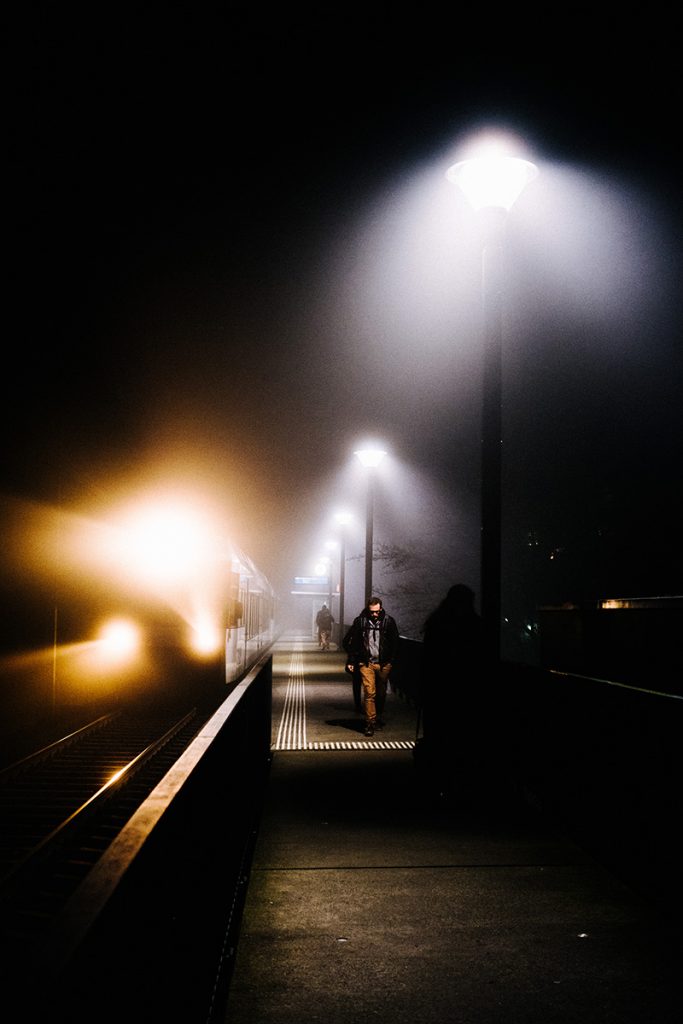
(c) Daniel Bachofen. Link. Creative Commons License.
Check the current price of the Fuji 27mm f/2.8 on Amazon.
Fuji 27mm f/2.8 pancake lens specs:
Filter size: 39 mm (plastic filter threads) | Weight: 78 grams | Size (LxW): 0.9″ x 2.4″ | Minimum Focus Distance: 13.3 inches | Hood included: No. But you can use any 39mm hood. You can get a third-party all-metal screw-in hood like this one.
Fuji 35mm f/1.4 R
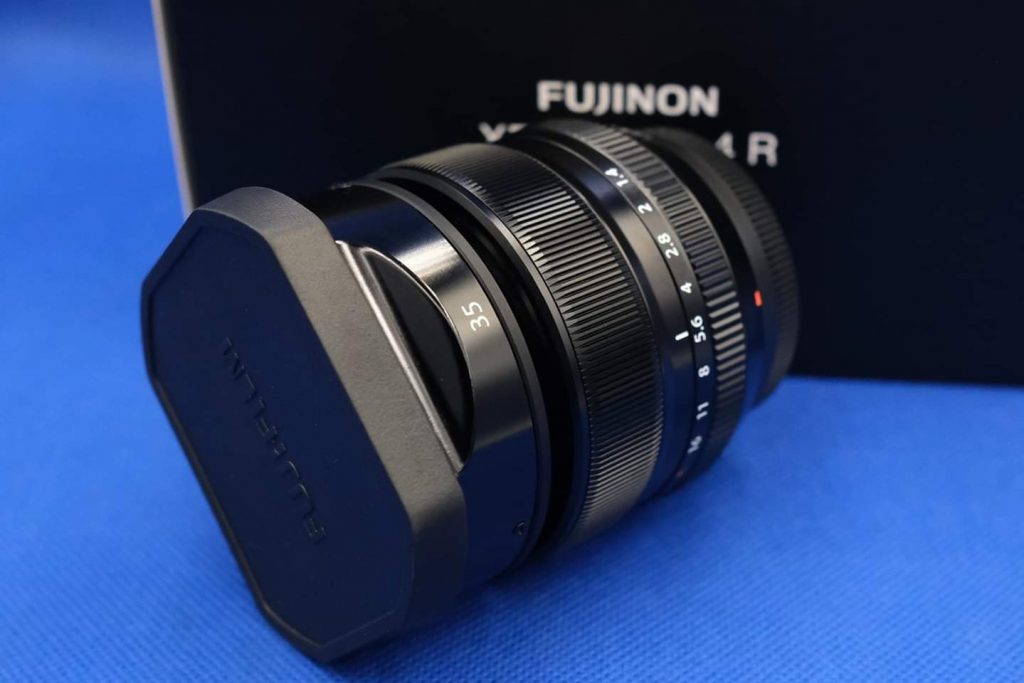
One of Fuji’s best rendering lenses. Period. The 35mm f/1.4 really needs no introduction. It’s one of the original three lenses that launched the X system, and to this day, it remains one of Fuji’s best lenses. A large part of the initial success of the Fuji X-mount can be attributed to this lens. With a ~50mm-equivalent field of view and a bright f/1.4 aperture, this is a standard lens and is very useful in a variety of situations. Street, travel, portraits, and everything in between. There’s a reason the 50mm-equivalent lens is one of the most popular focal lengths in photography.
With its fast f/1.4 aperture and small size, this lens became an instant classic when it launched. A large part of the initial success of the X-system can be attributed to this lens.
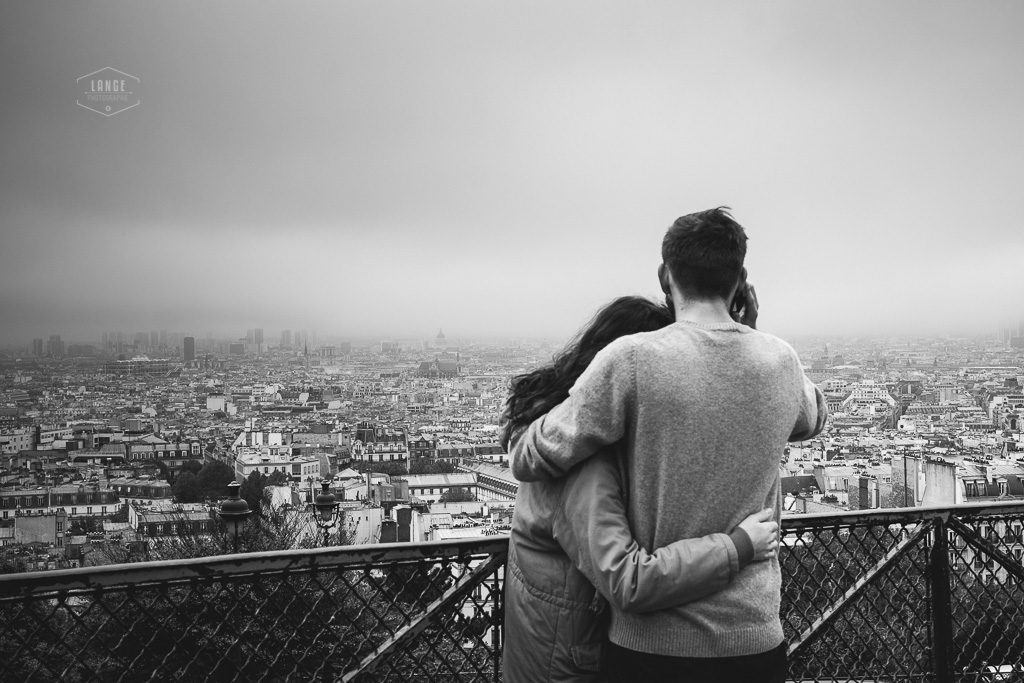
(c) Cedric Lange. Link. Creative Commons License.
The one thing that’s not so great about the 35mm f/1.4 is the relatively noisier and slower autofocus. No, it’s not as bad as when it first came out – firmware updates have improved the lens over the years, but compared to the newer lenses (like the 35mm f/2, below), this lens isn’t as snappy, and it does have an audible AF motor.
Auto focus speed has improved a lot since it was first released. I find it slower, but still somewhat competitive with current lenses. It’s slower if you do side-by-side tests, but on single AF, and especially on newer Fuji bodies such as the Fuji X-T30 or X-T3, the lens can hold its own against newer lenses in single AF mode. But if C-AF speed or quiet AF is of utmost importance (e.g, for video use), definitely get the 35mm f/2 version (below).
What makes this lens special is the way it renders, especially wide-open. It’s hard to explain, but it’s got a certain je ne sais quoi. It’s got character.
It’s extremely sharp wide-open. But not in a bad way. A lot of lenses nowadays are razor sharp from edge-to-edge, designed to get high marks on test charts, but in real world use, they render flat images which some find unappealing. They’re technically perfect, but the images don’t jump out at you.
Not so with the 35mm f/1.4. It’s crazy sharp in the center, and it renders in a very pleasing way. The gradual fall-off towards the out of focus areas results in images that are generally very pleasing. It’s got that “look” as some people say. Some don’t see it, and say it’s just fairy dust, but if you’re one of those who see it and appreciate it, you’ll know.
Like most fast aperture lenses, the edges and corners aren’t as good as the center when wide-open, but it’s a non-issue in most instances. It’s sharp where it counts. There is some slight vignetting wide-open, nothing to complain about, it’s easily corrected in post and is 100% gone stopped down to f/2.8.
This is a lens that doesn’t do well in test charts, but in the real-world, taking real photographs, it will never cease to amaze. If you’re looking for technical or mechanical perfection, this isn’t it. But if you love the normal 50mm-equivalent field of view, and a lens with just a little bit of magic – this is it. Really, this is it.
Oh, and if you want to shoot this wide-open in bright light (and why wouldn’t you? It’s just lovely wide-open) – I highly recommend you invest in a high quality ND filter.
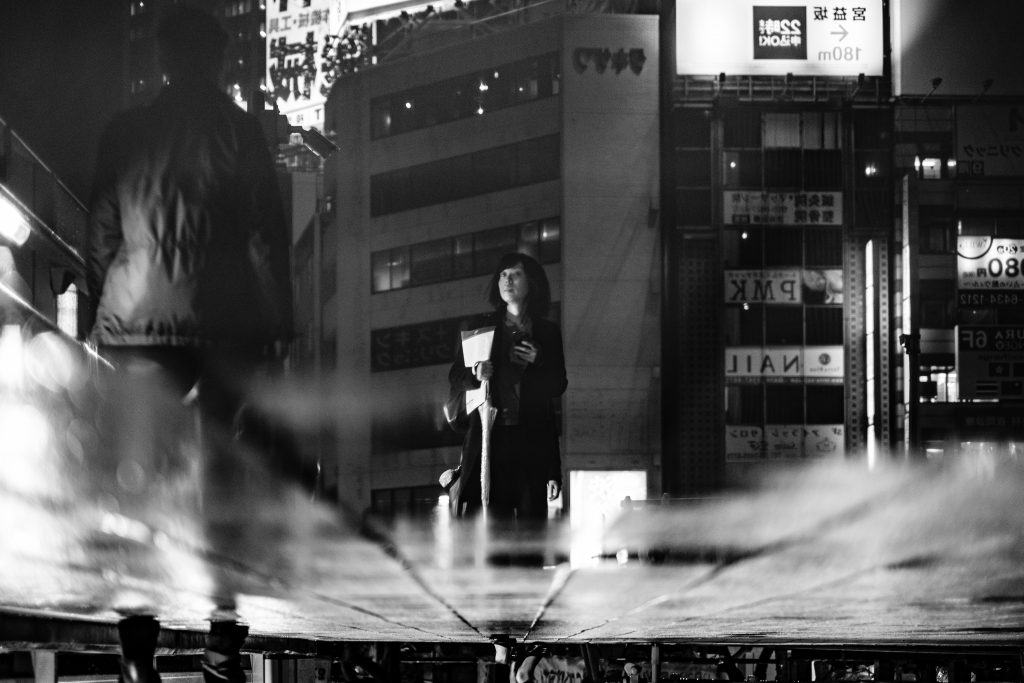
(c) Andrea Belvedere. Link. Creative Commons License.
Check the current price of the Fuji 35mm f/1.4 on Amazon.
Fujinon 35mm f/1.4 specs:
Filter size: 52 mm | Weight: 187 grams | Size (LxW): 1.98″ x 2.55″ | Minimum Focus Distance: 11 inches | Hood included: Yes. It comes with a nice metal hood with a push-on lens cap that falls off ALL THE TIME. You can replace it with a third-party hood like this one, with an easier to use pinch cap. Much less cumbersome. You’ll thank me later.
Fuji 35mm f/2 WR
The first of Fuji’s line of small, compact and weather-sealed lenses, the 35mm f/2 (53mm-equivalent FOV) competes with its brighter but older and slower f/1.4 sibling (above).
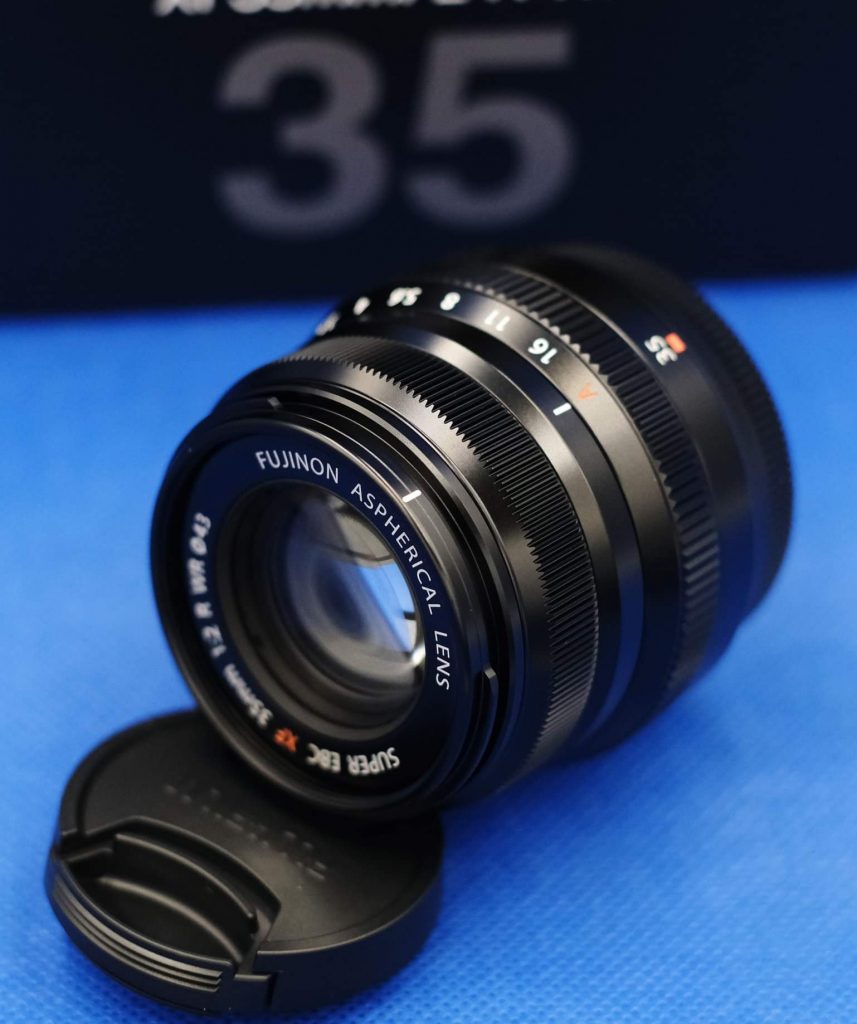
This lens represents one of the best values in the entire Fujifilm X-mount system right now. It’s small, focuses very fast, and perhaps more importantly, is ultra-quiet. Throw in weather sealing and a cheaper price, and it’s hard to argue against it.
Optically, this lens is actually slightly sharper across all similar apertures vs the f/1.4 lens (above), at mid to infinity focus. At closer distances, I find it inferior to the 35mm f/1.4 lens, but it is still not bad. Just like the 23mm f/2, there is a performance drop at close-focus distances, but in real world use, it is a non-issue. It is sharp enough for most uses. Don’t worry about what all these lab-testers tell you.
Since it’s “only” an f/2 lens, you’re obviously giving up a whole stop vs the 35mm f/1.4 (above), and as such isn’t as capable of blurring the background as its more celebrated sibling. BUT – one thing that does help a bit here is that the 35mm f/2 has 9 aperture blades vs the 7 blades on the 35mm f/1.4 which helps smooth out the out of focus rendering. No, bokeh still won’t be as good as the 35mm f/1.4 – but the extra blades help close the gap. Personally, I wouldn’t choose between these two lenses based on ‘bokeh’ rendering or in DOF control. Any time you find yourself wishing for a creamier background, you’re best getting a longer, faster lens.
Similar the 23mm f/2, the 35mm f/2 also features a tapered barrel design where the rear of the lens is fatter than the front end. This results in what I think is a weird looking lens, but the reason for this is so the lens will be much more useable with the optical viewfinder of the ‘rangefinder-like’ bodies such as the Fuji X-Pro2. If it didn’t have a tapered barrel, the lens might block the lower part of the look-through optical viewfinder.
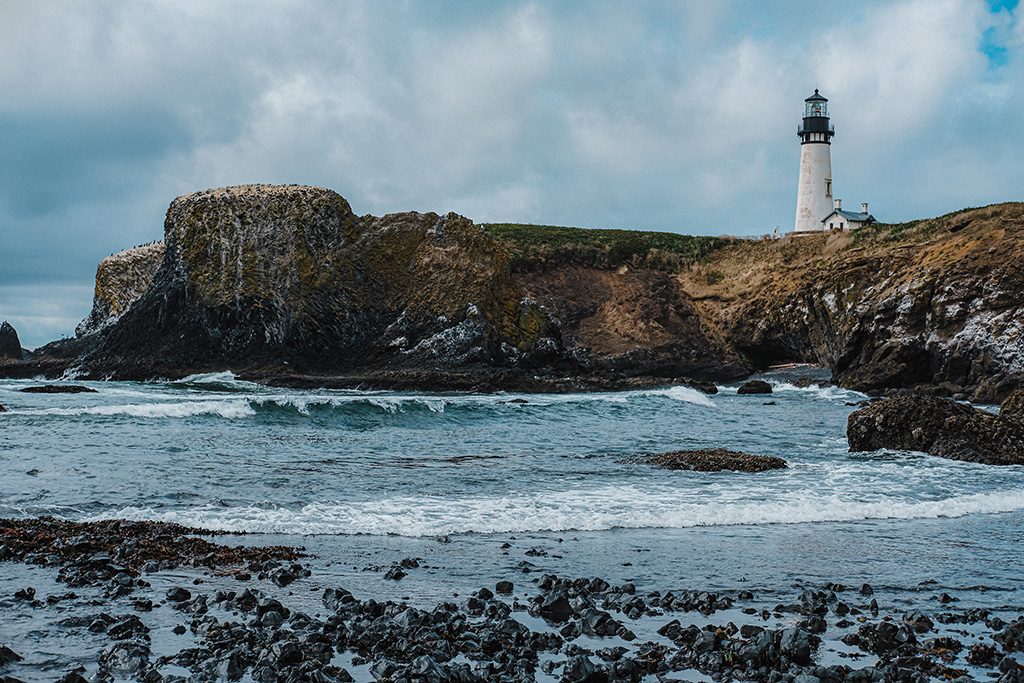
(c) Malicali. Link. Creative Commons License.
So, which is better – Fuji 35mm f/1.4 vs 35mm f/2?
There isn’t an easy answer in the great old Fuji 35mm f/1.4 vs 35mm f/2 debate. Regardless of whether you can ‘see’ the magic in the f/1.4 rendering or not, f/1.4 is f/1.4. It’s an extra stop. That could mean the difference between ISO 12800 and ISO 6400. The difference between a usable image vs one that you’ll only be able to show in small sizes on Instagram. But on the other hand, the combination of an updated AF motor, weather sealing and cheaper price are a compelling argument in favor of the 35mm f/2. At the end of the day, you’ll have to be clear on your priorities and on what you’re willing to compromise on.
You want the 35mm f/1.4 for its rendering, and for that extra stop – you want the f/2 for its quieter and faster autofocus, and for its weather sealing. Now, I ended up choosing the 35mm f/1.4. But if I wanted a lens for video, or once my daughter starts running around and the 35mm f/1.4 can no longer keep up? I’ll spring for the 35mm f/2.

(c) Ben Pugh. Link. Creative Commons License.
Check the price of the Fuji 35mm f/2 on Amazon.
Fuji 35mm f/2 specs:
Filter size: 43 mm | Weight: 180 grams | Size (LxW): 1.8″ x 2.4″ | Minimum Focus Distance: 13.7 inches | Hood included: Yes it comes with a small, low profile hood, like the one on the 23mm f/2 – you can also upgrade to the Fuji LH-XF35-2 lens hood which is a much nicer looking vented hood, but will add more length to your lens.
Telephoto Prime Lenses:
Fuji 50mm f/2 WR
This is the most recent addition to the ‘Fujicron’ trio – the other two being the 23mm f/2 and 35mm f/2. Small, fast, affordable and built extremely well, these trio of weather sealed lenses have really earned their place in a lot of Fuji shooters bags.
The 50mm f/2 is, by far, my favorite of the three, and I would actually list it as one of my top 5 lenses for the Fuji X system.
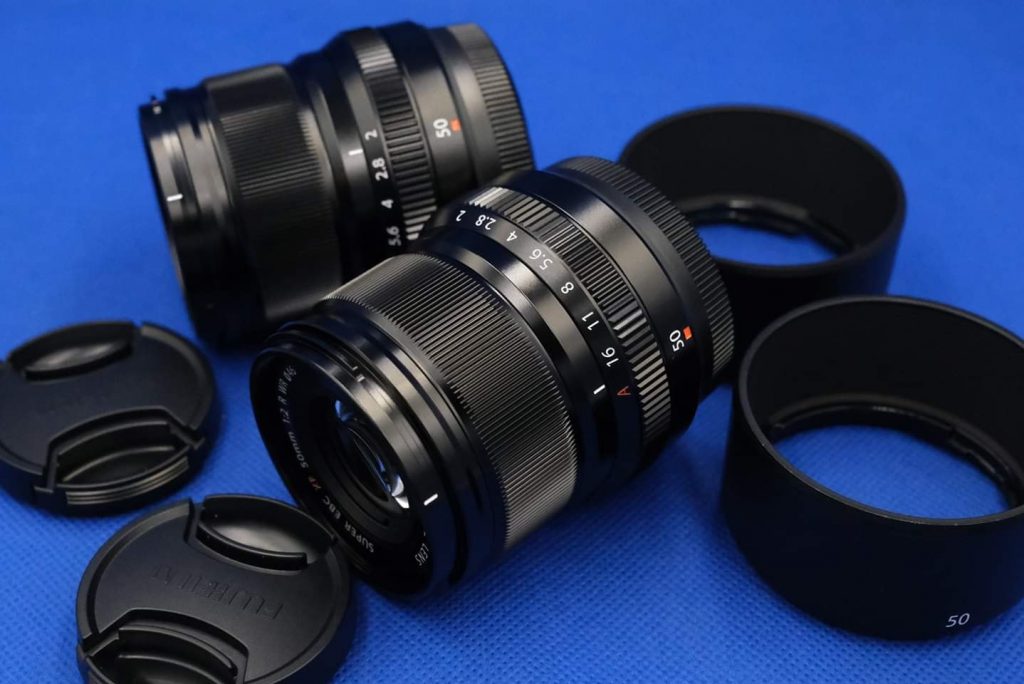
This lens is easily overlooked in favor of its more celebrated sibling – the Fuji 56mm f/1.2 (see below) – which I think is a bit unfortunate, since the 50mm f/2 just might be one of the best value lenses in the entire Fuji line-up.
Since it’s “only” f/2, I guess it just isn’t as sexy as f/1.2, and since it works out to a 75mm-equivalent on APS-C, it may appear to be a weird focal length vs the more traditional 85mm-equivalent on the 56mm.
Some people (who have never even used this lens) even call it a mere stop gap on the way to the 56mm f/1.2. I’ve seen people in forums say “just go straight for the 56mm, you’ll trade in your 50mm f/2 for the 56mm at some point”. Maybe. A lot of people do go that route. But to me, they’re two very different lenses.
The 56mm is a fantastic portrait lens, and if you’re a bokeh fiend, then it should be your top choice. But it’s also a significantly larger and heavier lens. It’s also slower to focus, making it more specialized. The depth-of-field at f/1.2 is very thin, making that lens a bit harder to use effectively, and without good, disciplined shooting technique.
The 50mm f/2 won’t obliterate the background like the 56mm, but it is still capable of some impressive background blur. Bokeh rendering is very smooth, and very pleasing. Unless you’re doing side-by-side testing vs a faster lens, I doubt many people will say the 50mm isn’t capable of some really nice out-of-focus rendering.
The 75mm-equivalent might seem weird at first, but this is actually one of the reasons why I’ve fallen in love with this lens. The mid-telephoto equivalent that’s shorter-than-usual 85mm focal length means this lens will be a hell of a lot more handy in indoor shoots.
In fact, I sometimes leave this lens on my X-E3, which serves as my ‘kitchen-table’ camera. That means it’s the camera responsible for taking pics of everyday moments at home. And the 50mm f/2 does it beautifully. We live in a small apartment, and the 50mm f/2 is able to shoot in tighter spaces vs the 56mm f/1.2.
Prior to owning this lens, I typically wouldn’t reach for a telephoto or anything longer than a 50mm-equivalent when shooting everyday stuff indoors, but this lens has certainly changed that and has opened up a lot of possibilities.
Adding to its usefulness in tight spaces, the 50mm f/2 also has a much closer minimum focusing distance (1.27 feet) versus the 2.3 feet MFD of the 56mm.
If you think this is merely a cheaper, smaller version of the 56mm f/1.2, you are mistaken. There is room for both in a kit. In fact, if you can only have one, I would recommend that most people get the 50mm f/2 over the 56mm f/1.2. Yep, really. The only reason people compare them is because they are “almost” similar in focal length, but that’s really where the similarities end.
The much faster AF speed alone means the 50mm f/2 is capable of more keepers than the 56mm. The ability to focus closer is a bonus, not only for indoor shooting where you won’t always have space to back-up, but also for general everyday shooting, where you want to get closer to details.
Aside from being a much smaller lens (in both girth and length) and much lighter on the wallet, the 50mm is also half the weight of the 56mm, making it easier to bring along for those just-in-case shooting excursions.
I can actually fit my X-E3, 23mm f/2 and the 50mm f/2 in a small waist/sling bag. It’s as small and light as a micro-four-thirds set-up and they’re weather sealed. (Despite having one of the most extensive weather sealed lens line-ups, and with the exception of the Panasonic 25mm f/1.4 version II, most of the smaller micro four thirds primes are actually not weather sealed. If you want weather sealing in m43 land, you’ll have to go with a zoom lens or one of the much larger PRO primes)
Similar to the 23mm f/2 and 35mm f/2, the 50mm f/2 also has a tapered barrel design (fatter near the lens mount, and slimmer towards the front), so it won’t block too much of the optical viewfinder on an X-Pro series body.
Also similar to its siblings, the 50mm f/2 is weather and dust resistant, and will operate to as low as -10°C.
One annoying thing about the 50mm f/2 is that it comes with a larger 46mm filter thread vs the 43mm filter threads on both the 23mm and 35mm Fujicrons. That’s not a deal breaker, obviously, but it would have been nice to be able to easily share filters between the three, since they’re a pretty popular trinity for Fuji prime shooters.
The 50mm comes with a serviceable plastic hood. Unlike the small hoods for the 23mm f/2 and 35mm f/2, the hood for the 50mm is much longer. But unlike the stock hoods for the 23mm and 35mm, this one thankfully reverses into the lens for storage.
I’m probably in the minority when I say this lens would be more useful for most people vs the 56mm f/1.2 – but if you do have the chance to pick this lens up, please do. You will be surprised. As long as you understand that it won’t obliterate backgrounds like the 56mm f/1.2, you’ll find that this is a gem of a lens that performs well above its price tag.
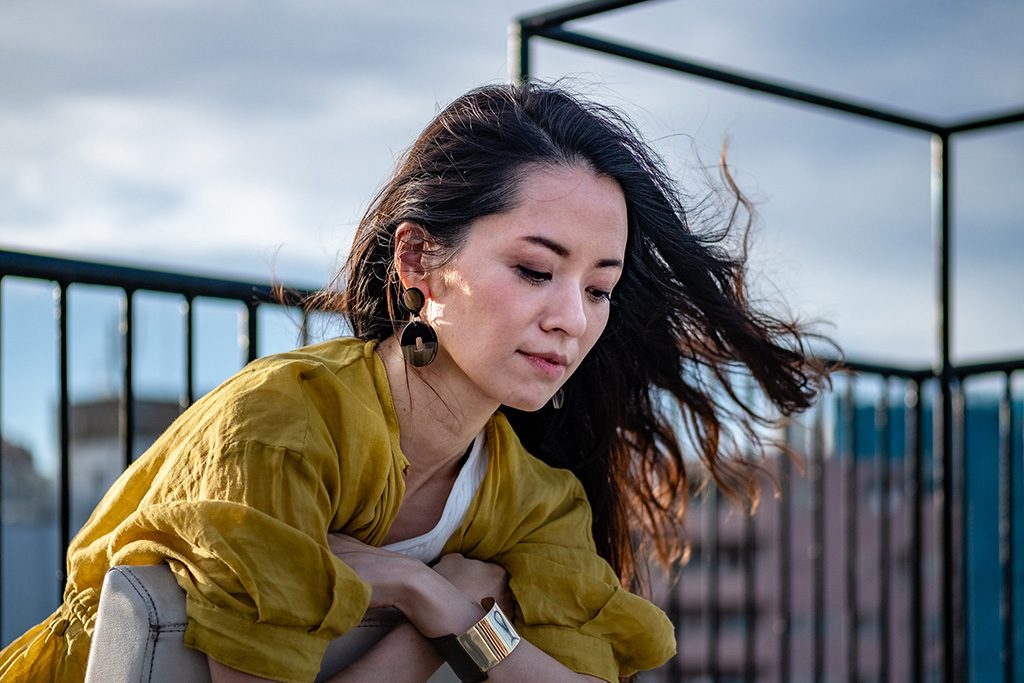
(c) Andrea Belvedere. Link. Creative Commons License.
Check the price of the Fuji 50mm f/2 on Amazon.
Fuji 50mm f/2 specs:
Filter size: 46 mm | Weight: 200 grams | Size (LxW): 2.33″ x 2.36″ | Minimum Focus Distance: 15.35 inches | Hood included: Yes
Fuji 56mm f/1.2 R
f/1.2 baby. Say it with me, one point two!

(c) Axel Kuhlman. Link. Creative Commons License.
The creamy bokeh and very pleasing fall-off that this lens produces is the reason you want this lens. You don’t have to read all the paragraphs below, the TLDR is that this is the portrait lens you’ve been looking for.
The ultra-fast 56mm f/1.2 is Fuji’s answer to the classic, workhorse, 85mm portrait prime. On a Fuji APS-C camera, this lens delivers an ~85mm equivalent field of view, which is a nice, tight focal length that is especially flattering for portraiture.
At 405 grams, this is one of the heaviest lenses in Fuji’s prime lens lineup, but all things considered, it’s not really a hefty lens by most standards. It is lighter and smaller than your typical full frame 50mm f/1.4 or full frame 85mm f/1.8 lens.
It’s actually very slightly smaller and lighter than the Panasonic Leica 42.5mm f/1.2 Nocticron lens for the micro-four-thirds system (m43), which also delivers a similar 85mm field of view. This Fuji 56mm f/1.2 actually has a smaller 62mm filter thread vs the larger 67mm filter thread on the Panasonic Leica Noctictron, a lens for a smaller format. Bottom line, the 56mm f/1.2 is a hefty lens relative to most Fuji primes, but it’s not the boat anchor it’s sometimes made out to be.
The lens balances well on the likes of the Fuji X-T2 or X-T3, and it isn’t too bad on smaller bodies like the X-T20, X-T30 or X-E3. When I say it’s not too bad, I mean it’s not really unwieldy, but it’s still not something you’d want to carry around all day without worrying about fatigue (unless you get an optional grip or thumb grip on your X-E or X-T body).
Besides, the 56mm is really best suited for the higher end bodies since you get that extra mechanical shutter speed up to 1/8000, allowing you to shoot wide-open in bright environments, which means less fiddling with filters.
Like most Fuji lenses, it has a nice metal barrel and a smooth aperture ring. One minor niggle is that I wish there was more distance between the f/1.2 mark and the f/1.4 mark on the aperture dial as I found myself accidentally shooting at f/1.4 instead of wide-open on more than one occasion. It’s one of those YMMV things, but it did bother me enough times.
There is some vignetting wide-open, but that is to be expected from an ultra-speed lens. It’s a non-issue in the majority of real world shooting scenarios, and is mostly gone by f/1.8. Vignetting is actually less vs the Sony FE 85mm f/1.8 on full frame. For an ultra-fast lens, there is also practically no color fringing at the fastest apertures, which is a nice and welcome surprise.
Unfortunately, the 56mm f/1.2 does not have optical image stabilization or weather-sealing, which would have been nice to have, especially at this price point. But that would have added to the heft of the lens.
In good light, the 56mm f/1.2 focuses fast and accurately. In low light, it does struggle quite a bit, more so than the newer lenses such as the 50mm f/2, or even older lenses like the 23mm f/1.4.
Focusing speed is greatly improved on newer bodies such as the Fujifilm X-T3, but this is perhaps a great time to remind you that this isn’t a lens to be used carelessly. Good technique is a must.
There are some bodies that will help you achieve a higher hit rate – e.g. the better AF of the Fuji X-T3 or the IBIS of the Fuji X-H1 or the upcoming Fuji X-H2 etc.. but at the end of the day this isn’t a lens that you throw on the camera and just point and shoot and expect knock-your-socks-off results.
Focusing at f/1.2, in low light, or with moving subjects, even with the aid of face detect and eye detect AF, takes practice and patience. This isn’t a lens where you’ll get over 90% hit rate on your first day with it. But if you take your time, and learn to use it within its limitations, it will reward you greatly.
As expected from an f/1.2 lens that’s designed for portraits, this lens renders some incredibly creamy bokeh when shot wide-open. More importantly, it is also sharp and contrasty when shot wide-open. This isn’t unexpected from Fuji, but you’d be surprised at the number of ultra-fast lenses that are hazy when shot at their widest apertures. The overall rendering of the 56mm f/1.2 is absolutely fantastic to my eyes. It’s not as creamy as an 85mm f/1.4 on full frame, but oh boy, is it gorgeous.
If you’re serious about your portraits, you need to invest in this lens. If you’re a portrait pro and not sure whether to get this or the Fuji 90mm f/2 for portraits, get this first. The focal length alone means it’s much more versatile and useful vs the 90mm f/2. The 90mm is more of an outdoor lens, while the 56mm will work in most indoor scenarios, is easier to hand hold in low light especially on a body with no IBIS and is more than a full stop brighter. Overall, if you can only have one at this time, get the 56mm, it has a wider shooting envelope and will spend little time sitting in the bag.
Most f/1.2 lenses for other systems are ‘halo’ products. They’re designed to show-off, meant to be used by brand ambassadors, but not by you and me. Not only are these lenses ridiculously large and hefty, they are also priced obscenely compared to other lenses in the line-up, that you just know the manufacturer doesn’t expect to sell a lot of them. Not so with the Fuji 56mm f/1.2. This is a lens that’s actually meant to be used by the majority of Fuji shooters.
Yes, it’s slightly pricier than most Fujinon prime lenses, but not obscenely so. In fact, I’d go as far as to say it’s actually priced very well at all. You’re getting quite a lot of lens for the money. It’s an easy recommendation for any Fuji shooter who understands what they’re getting and who is willing to invest the time to learn to use it properly.
Check the price of the Fuji 56mm f/1.2 on Amazon.
Fujinon 56mm f/1.2 specs:
Filter size: 62 mm ; if you shoot outdoors in bright light, you’ll probably want at least a 3-stop ND filter (ND8) | Weight: 405 grams | Size (LxW): 2.74″ x 2.89″ | Minimum Focus Distance: 27.5 inches | Hood included: Yes
Fuji 56mm f/1.2 APD
The APD version of the 56mm f/1.2 is basically the same lens as the 56mm R above, but it includes a built-in Apodization (APD) filter. This internal clear filter helps smooth out the transitions in out of focus highlights (bokeh rendering) when shooting at the fastest apertures.
In many cases, the effect is very subtle, but it is definitely more pleasing, but you’ll really only notice when doing side-by-side comparisons vs the regular 56mm f/1.2.
Basically, if the primary goal is to get buttery smooth out of focus background rendering, the APD version is the one to get.
So this makes the APD version the better lens right?
Well, it depends. The addition of the internal, non-removable APD filter also brings with it three downsides:
- The APD version is about 50% more expensive than the regular version
- You can only use contrast-detect auto-focus with the APD version
- There is some loss of light due to the apodization filter
Now you know why the APD version is a specialized lens, and why it isn’t for everyone.
The 56mm f/1.2 has never been known to be one of Fuji’s best AF performers, and if you regularly shoot in low-light situations, the loss of phase-detect AF on the APD version is automatically going to be a deal-breaker for most people. Although it should be noted that this is typical of pretty much all APD lenses at this time. It used to be that most lenses with APD filters were manual focus only. So I guess the ability to use AF, even if it’s only through contrast-detect AF is a relatively huge improvement.
The use of an APD filter also reduces the amount of light passing through the lens. To show this, the aperture ring of the APD version shows the effective aperture in red text, beside the actual aperture numbers (see image below). The strength of the effect of the APD filter can be judged by the difference between the effective aperture (in red) and actual aperture (in white). As you can see in the image below, the effect is more pronounced when shooting in the fastest apertures.
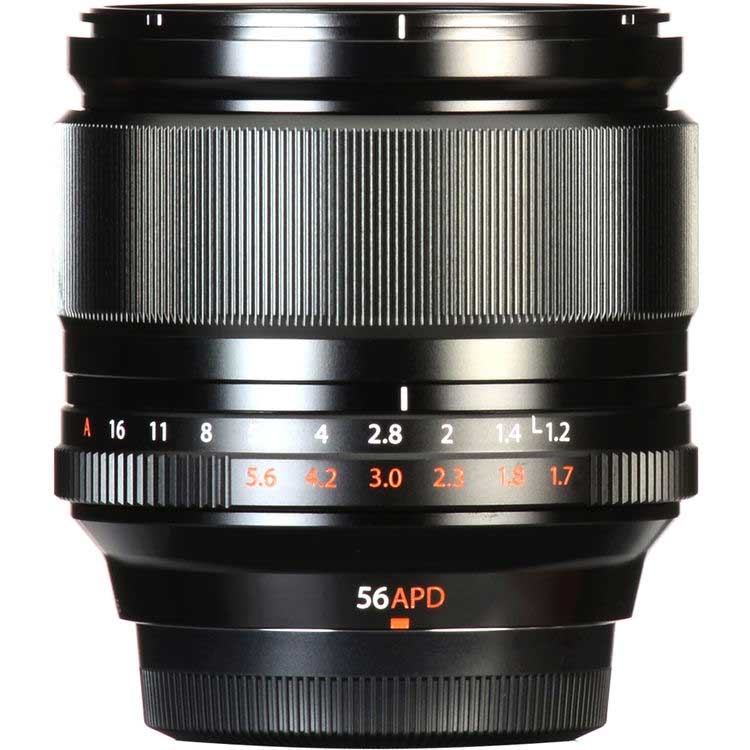
Basically, you’ll want to shoot this lens wide-open most of the time. To help with this, Fuji is kind enough to include a 3-stop neutral density filter (ND8) in the retail package of the APD version. If you’re unfamiliar with ND filters, they basically reduce the brightness of the light entering the lens, allowing you to use bright apertures even in bright daylight, without needing to use the electronic shutter. The ND filter included with the APD version is an ND8, meaning it reduces the light entering the camera to an 8th of its actual value, or the equivalent of 3-stops.
Overall, the APD version isn’t for everybody. Most people are better off saving $500 and getting the regular 56mm f/1.2 version.
Yes, the effects of the APD filter are nice, and if we’re talking purely of output, I’d say it’s worth paying extra for. But all things considered, given the higher price and the loss of phase-detect auto-focus, it’s a bit of a hard sell. But if you do a lot of posed portraits in very well lit environments (e.g. in a studio), this one is for you.
Check the price of the Fuji 56mm APD on Amazon.
Fuji 56mm f/1.2 APD specs:
Filter size: 62 mm ; ND8 (3-stops) filter included in the retail package | Weight: 405 grams | Size (LxW): 2.74″ x 2.89″ | Minimum Focus Distance: 10.5 inches | Hood included: Yes
Fuji 60mm f/2.4 Macro
The 60mm macro is probably the most overlooked Fuji lens. One of the three original lenses that were first released for the X-mount (together with the 18mm f/2 and 35mm f/1.4), this is a lens that doesn’t seem to appear in a lot of bags these days.
The 60mm f/2.4 is primarily a macro lens capable of 0.5x magnification (1:2). If you want a 1:1 macro lens, you’ll have to take a look at the 80mm f/2.8 (see below)
But in the very early days of the X-mount, this was also the lens to own if you wanted to do portraits, although these days it’s been mostly replaced by faster, sexier offerings like the 56mm f/1.2 and 50mm f/2.
Does that mean it’s no longer recommended over the 2 short tele-primes? Hardly.
If you only occasionally shoot portraits, and want something that can shoot really close, the 60mm is worth the consideration. With its 9 aperture blades and a 90mm-equivalent FOV, the 60mm can more than hold its own in a portrait shoot. (The 56mm only has 7 aperture blades).
The 9 aperture blades really allow it to render some really smooth and fantastic looking bokeh. Yes, the 56mm f/1.2 is still going to create more blur because it’s more than 2 stops faster, but compare them at similar apertures and you can see that the 60mm actually renders smoother bokeh.
And, it does this at a smaller size and much lighter weight than the 56mm f/1.2.
And the best part? It’s quite a bit cheaper than the 56mm f/1.2. If you want a lens that can occasionally do double duty as a portrait lens, you could save quite a bit more by getting the 60mm. The money saved vs the 56mm f/1.2 can get you a wider prime to pair with the 60mm. (e.g. 23mm f/2 or 18mm f2, etc..)
The 60mm does come with another downside that might be a bigger deal-breaker than the slower aperture. Being one of the oldest lenses in the Fuji X-mount line-up, it isn’t equipped with their most modern AF system. Add the fact that it’s a macro lens, and you’ve got a very leisurely focusing lens.
Actually, leisurely is an understatement. Even the 56mm f/1.2 auto-focuses faster that this lens. I haven’t had the opportunity to try this lens on an X-T3 yet, but I seriously doubt it will improve by leaps and bounds. This is not a lens designed for chasing your kids around.
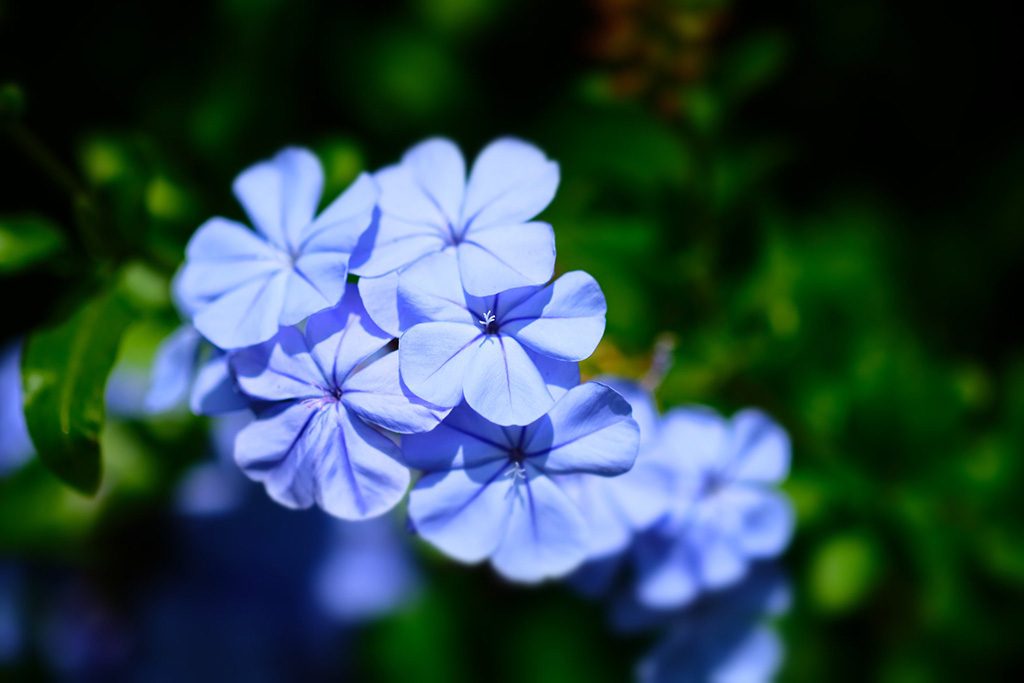
(c) Brian Gonzales. Link. Creative Commons License.
Check the price of the Fuji 60mm f/2.4 Macro on Amazon.
Fujinon 60mm f/2.4 specs:
Filter size: 39mm | Weight: 215g | Size (LxW): 2.5″ x 2.52″| Minimum Focus Distance: 26.7cm| Hood included: Yes, but it’s huge. Too big.
Fuji 80mm f/2.8 R LM OIS WR Macro
The best macro lens in Fuji’s lineup. The Fuji 80mm f/2.8 is a telephoto (120mm-equivalent) macro lens capable of true 1:1 magnification. As of this date, it is the only Fujinon lens capable of 1.0x magnification.
With 16 elements in 12 groups, including 1 aspherical lens, a super ED lens and 3 ED lenses, Fuji really went all out with this lens. NOTE: When you hold this lens when it’s not attached to a body, you can feel the floating elements moving around inside, this is normal.
The big news is the addition of optical image stabilization, allowing for handheld shooting, which is always a big plus in macro shooting. If you’ve never tried shooting macro, you’ll find that it’s pretty hard to keep things steady once you get to higher magnification and closer to 1:1 reproduction.
Officially, the 80mm macro’s image stabilizer is rated for just under 5 stops. But in real world shooting, as you focus closer in macro mode, that drops down to about 3 stops.
The other big news is the addition of a linear focusing motor, allowing for fast and silent autofocus, especially if you compare it to the 60mm f/2.4 which uses a much older AF system.
Because it’s a true 1:1 macro lens, this lens is quite a bit bigger than the older 60mm f/2.4 macro (above) which is only capable of doing 1:2 macro.
Optically, macro lenses are typically some of the best performing lenses in ANY system. Just look at the famed Voigtlander 60mm f/2.4 APO-Lanthar for the Sony FE, for example. A phenomenal lens.
In this case, the Fuji 80mm f/2.8 is no exception. Taking sharpness, micro-contrast and resolution into account, it’s one of the best in Fuji’s growing lens line-up.
It can double as a portrait lens, though in my opinion it isn’t quite as good as the 60mm f/2.4 in this regard. While the background is obliterated at macro distances, at portrait distances it isn’t quite as good. The f/2.8 probably has a bit to do with it, but it’s also the overall rendering. It’s just too damn sharp. Not something that you want in a portrait lens. Fall-off isn’t quite as good, and the bokeh has a bit of harshness to it that can really be distracting depending on what’s in the background.
Overall, if I wanted something that can do double duty as a macro and portrait lens, I’d probably spring for the 60mm f/2.4.
Unless of course you want a true 1:1 macro, which means this is your only choice. If you do a lot of product photography, or are seriously into macro work, this is the one for you.
Another advantage of the 80mm is that it is one of very few Fuji lenses compatible with the Fujinon XF 1.4x TC and Fuji XF 2x TC teleconverters. (The other two being the Fuji 50-140mm f/2.8 zoom and the Fuji 100-400mm f/4.5-5.6 zoom)
With the XF1.4X TC, the 80mm becomes a 112mm f/4 lens (equivalent to a 171mm field of view) and with the XF2x teleconverter, the 80mm will become a 160mm f/5.6 lens (equivalent to a 244mm field of view). So you can essentially get two lenses in one with just a small adapter. An 80mm macro slash portrait lens, and a 112mm or 160mm telephoto for ‘scapes.
It’s a hefty lens, as large as a DSLR 105mm macro lens, but it is still smaller and lighter than the Fuji 50-140mm f/2.8.
Despite being a macro lens, the linear AF motor really shows its benefits here. It’s not as leisurely to AF as most macro lenses. One thing helps in this regard is the AF limiter switch on the lens. You get three choices: 9.8 inches to 1.6 feet; 1.6 feet to infinity or; the whole range from 9.8 inches to infinity. It’s not the lens for sports or for kids running around, but it autofocuses pretty fast for a macro lens.
It’s also dust and weather sealed, designed to operate in as low as -10C. The front element is coated with flourine, which helps repel water. Really useful when you’re down in your hands and knees shooting in wet and humid conditions.
Overall, this lens isn’t going to generate as much fanfare as say, the 56mm f/1.2 or the 50-140mm f/2.8, but for the right kind of shooter, it is the perfect lens.
Check the current price of the Fuji 80mm f/2.8 Macro on Amazon.
Fujinon 80mm f/2.8 macro specs:
Filter size: 62 mm | Weight: 750 grams | Size (LxW): 130mm x 80mm | Minimum Focus Distance: 9.84 inches | Hood included: Yes
Fuji 90mm f/2 R LM WR
With a 35mm-equivalent field of view of 137mm, Fuji’s 90mm f/2 WR prime lens completes their portrait combo (along with the 56mm f/1.2). But unlike the 56mm, the 90mm comes equipped with quite a few improvements. It’s one of the first Fuji lenses to employ their quad-linear auto focusing technology, which is a step-up from the triple-linear focus system like on the 50-140mm f/2.8 zoom. This allows the lens to focus in as fast as 0.14 seconds with the latest and greatest Fuji bodies.
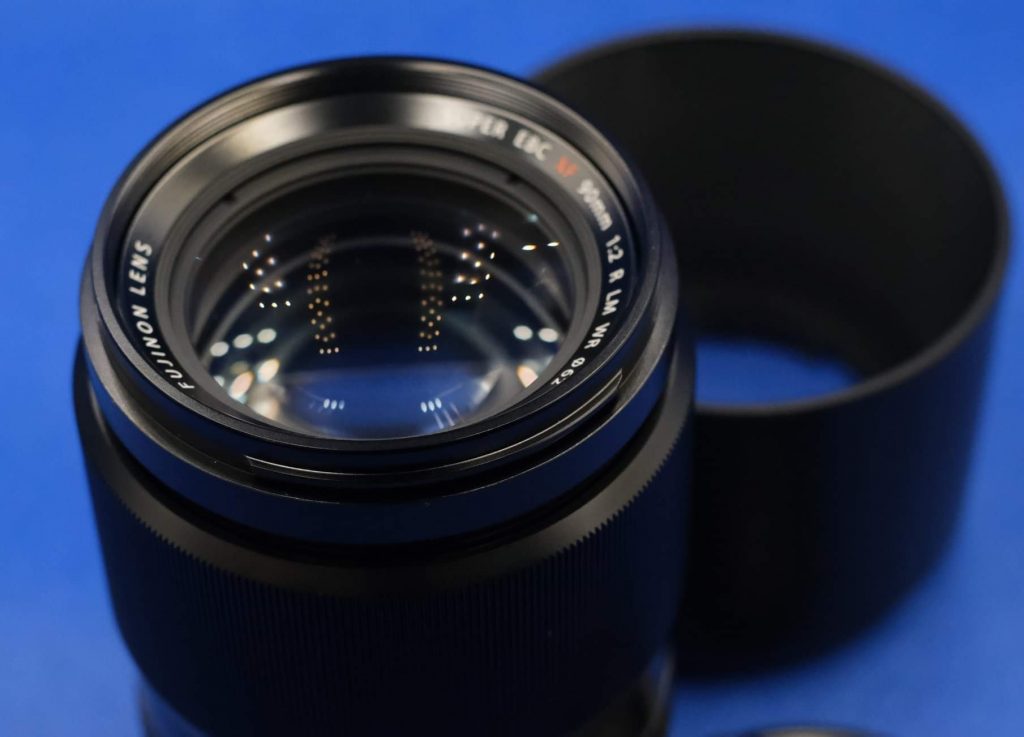
Another improvement over the 56mm is the addition of full weather-sealing. The 90mm is weather and dust resistant, and can work in temperature as low as -10 Celsius. It features a rubber ring on the lens mount to ensure that the lens remains dust and splash proof.
If you’re planning on getting this lens, or if you’ve recently ordered this lens, it is perhaps important to note that when your lens isn’t mounted on your camera, or when your camera is turned off, you will feel and hear the floating lens element moving inside the lens. Don’t panic, this is completely normal. This is because the magnets used to drive the focus system don’t engage when the lens is not in use, leaving the floating lens element to rattle around freely. The 50-140mm f/2.8 zoom also has a similar rattle.
For portrait shooters who will likely have both the 56mm and this lens in the bag, you will be pleased to know that the 90mm f/2 shares the same filter size as the 56mm f/1.2.
What if you could only have one for now? 90mm vs 56mm? My vote goes for the 56mm f/1.2. Unless you shoot outdoors majority of the time. The 56mm is simply more versatile, and is significantly easier to use indoors. You won’t always have space to effectively use the 90mm (137mm-equivalent) in some indoor areas.
But if you don’t think you’ll ever run out of space, and if you want the best AF performance in a portrait lens, the 90mm is the way to go. AF performance (especially on pre-XT-3 bodies) is just on another level. Not only is the 90mm faster to AF, it is much quieter too.
Another thing to consider is that the lack of OIS will be felt more with the 90mm than the 56mm. Unless you’re shooting on a body with IBIS such as the Fuji X-H1, you’ll be able to more easily handhold the 56mm with slower shutter speeds vs the 90mm. Shooting on bodies with no IBIS, I find that I hardly ever get a good hit-rate with the 90mm if I go below 1/100th.
But if you’re really serious about your portraits, you will have to find space for both the 90mm and 56mm in your bag. They’re really very different lenses, and you will find use for both.
The 90mm f/2 is an incredible portrait lens, capable of satisfying bokeh-connoisseurs (like the 56mm, the 90mm also has 7 rounded blades), it is extremely well built, is fully weather sealed and features some of Fuji’s latest AF technology. It’s big, and may perhaps be called heavy by some, but it’s all relative. As someone who is typically not a fan of large and heavy lenses, I’d call this lens ‘satisfyingly weighty’ but not obscenely so.

(c) NC Cheung. Link. Creative Commons License.
Check the current price of the Fuji 90mm f/2 on Amazon.
Fujinon 90mm f/2 specs:
Filter size: 62 mm | Weight: 540 grams | Size (LxW): 4.13″ x 2.9″ | Minimum Focus Distance: 23.6 inches | Hood included: Yes
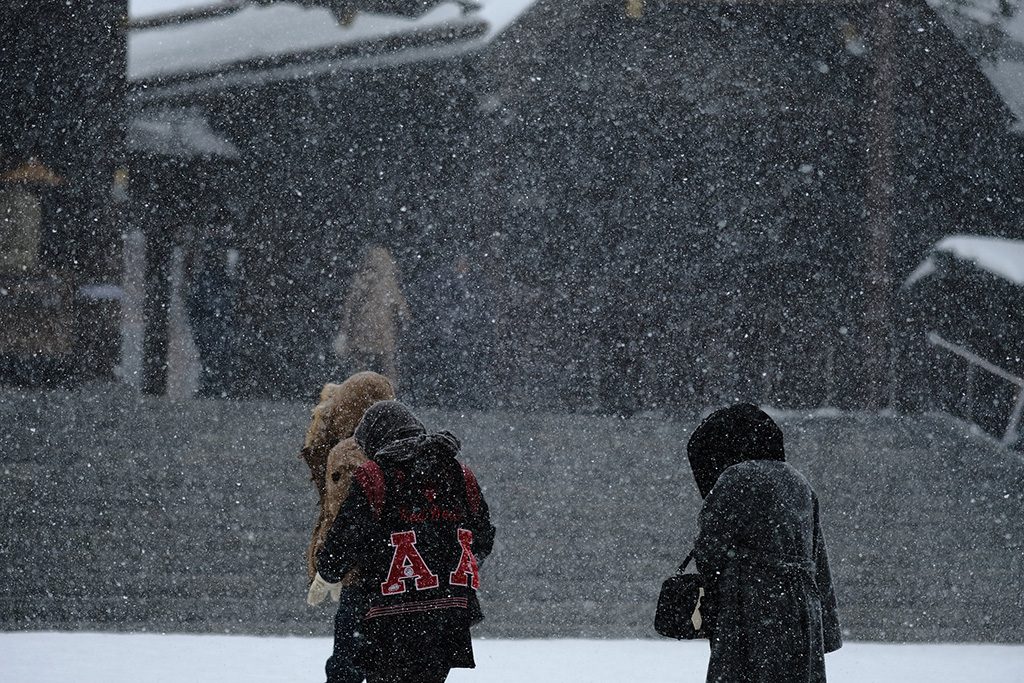
(c) Shuhei S. Link. Creative Commons License.
Fuji 200mm f/2
The Fujinon XF 200mm f/2 R LM OIS WR lens is currently Fuji’s longest prime lens and man, is it a beast! Just by virtue of its size and focal length, it’s not really something that interests me, but if you’re a serious wildlife shooter looking for a fast telephoto to take on safari, this just might be the perfect lens.
It’s fully weather-sealed, has image-stabilization rated up to five stops, includes a focus limiter (1.8m to infinity; 5m to infinity), tripod collar and is sold with the also new XF 1.4X TC F2 WR teleconverter (bringing you to a 420mm-equivalent reach).
The teleconverter is also weather sealed (as denoted by the WR in its name) and turns the lens into a 280mm f/2.8 equivalent (~427mm-equivalent FOV).
The tripod collar is non-removable, but is rotating. It’s Arca-swiss compatible, and can be directly mounted to a tripod or monopod and includes support for both 1/4″ and 3/8″ tripod screws for mounting quick release plates. The tripod collar also includes eyelets for the includes shoulder strap.
As expected from Fuji, this lens also features an aperture dial. Aside from the focus limiter switch, there is also a switch for the optical image stabilization system, a focus-preset switch (allowing you to jump to a pre-set focus distance) and a ‘focus control button’ near the front of the lens. This customizable button can be assigned to AF-on or focus lock, if desired.
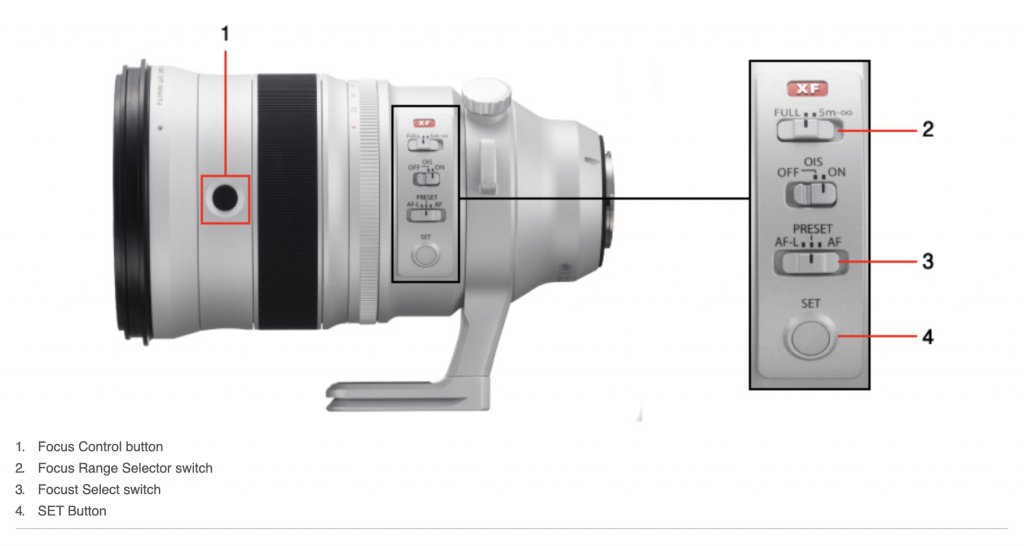
Click here to check the current price of the Fuji 200mm f/2 on Amazon.
Fuji 200mm f/2 specs:
Filter size: 105 mm | Weight: 2265 grams for the lens only (add 130 grams for the teleconverter) | Size (LxW): 8.1″ x 4.8″ for the lens only (the teleconverter is 2.28″ x 0.6″| Minimum Focus Distance: 70.1 inches (12x max. magnification) | Hood included: Yes | Others: also included with this lens is the Fuji XF 1.4X TC weather-sealed teleconverter, a shoulder strap, and a lens pouch
Upcoming lenses (announced):
Fuji XF 50mm f/1.0 R (replaces the previously in-development 33mm f/1)
Yep, you read that right. An f/1.0 lens. Not expected until 2020 at the earliest, the Fujinon 50mm f/1.0 is going to be the worlds first f/1.0 mirrorless lens with AF capability, unless some else beats them to it. 😉
As expected from an ultra-speed lens, this lens is going to be quite hefty. The initially rumored lens was a 33mm f/1.0, but initial mock-ups showed quite a humungous lens with a 77mm filter thread. But in September 2019, Fuji announced that they were scrapping the 33mm f/1 in favour of a 50mm f/1.0, which will be a fair bit smaller and pricier than the 33mm which was previously shown.
We’ll have to wait a bit more for this one, but it’s expected to be something special. Of course, the price is likely going to be quite something as well.
You can see the latest Fuji lens road map right here.
Upcoming lenses (rumored):
No hard rumors of other upcoming lenses at this time.
There have been rumors of an updated Fuji 18mm f/2 II prime for some time. Some rumor sites have claimed that this lens is currently in Fuji’s internal lens roadmap. But as to whether it will materialize is anyone’s guess at this point.
CompactShooter.com is a participant in the Amazon Services LLC Associates Program, an affiliate advertising program designed to provide a means for sites to earn advertising fees by advertising and linking to Amazon.com. This means that we get a small commission on products sold through affiliate links at no extra cost to you.
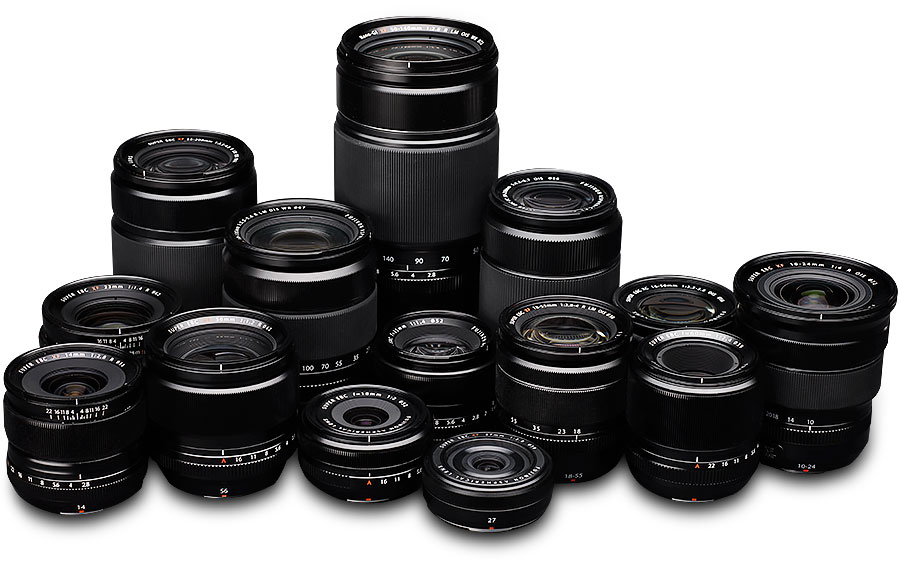
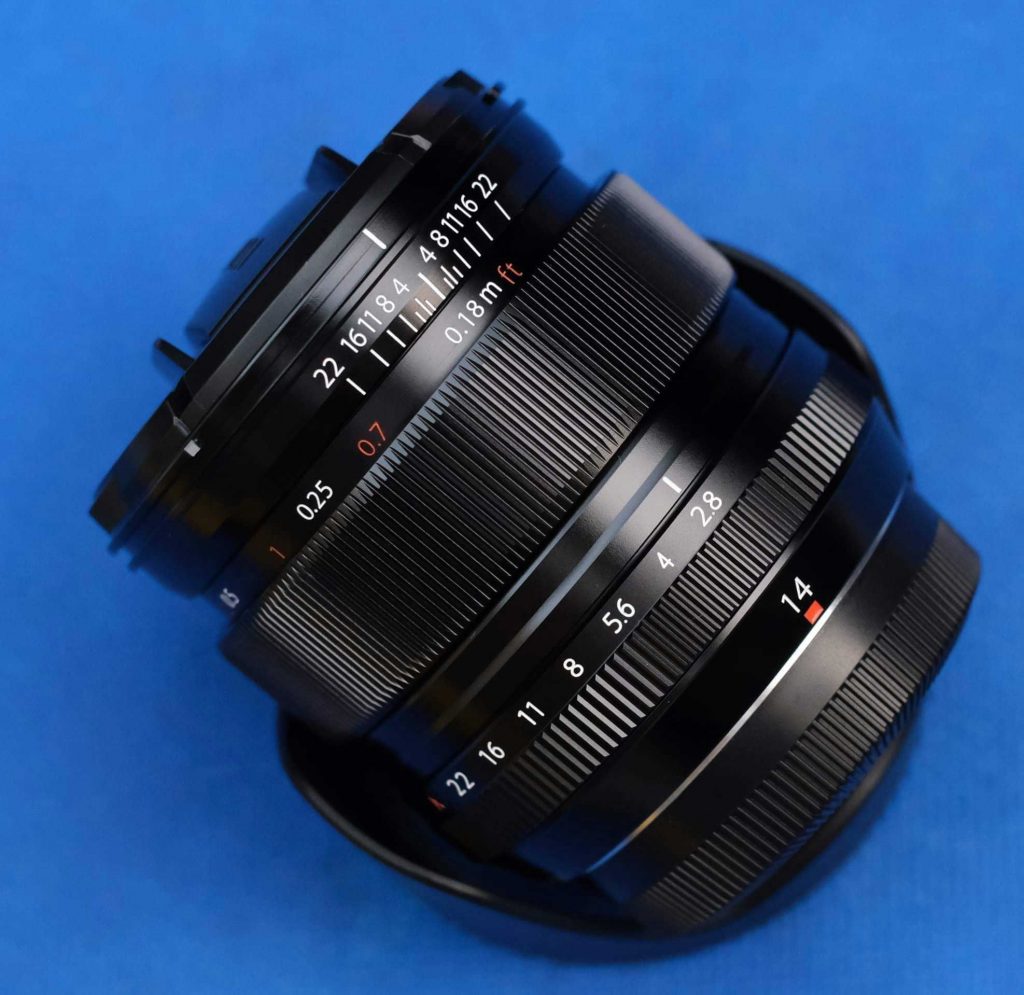
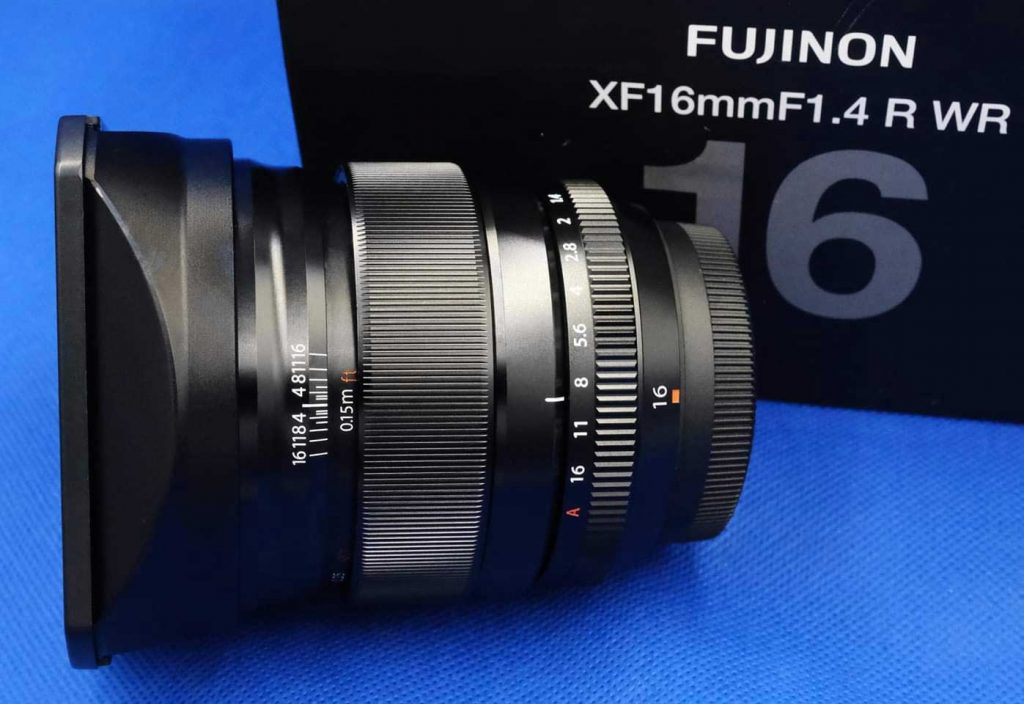
The current rumor is that there is an upcoming Fujinon XF 27mm f/2.8 Mark II. Seems legitimate as it looks like the same optical design in a housing with an aperture ring.
In a time of tightened budgets in the time of COVID, it’s a low cost update with guaranteed profits and a counterpoint to the expensive, large 50mm f1.0 lens